Flexible Antennas for a Sub-6 GHz 5G Band: A Comprehensive Review
Abstract
:1. Introduction
- Materials and design parameters needed for the design of flexible antennas are reviewed.
- A detailed classification of a single element, array, and MIMO flexible antennas in the recent literature is studied and a detailed analysis of different methodologies and their effect on the flexible antenna performance characteristics, such as reflection coefficient, gain, radiation pattern, the effect due to bending and the SAR are reviewed.
- Based on that, single element flexible antennas for sub-6 GHz 5G are reviewed by classifying the same into slot/slit-based, DGS-based, metamaterial-based, DRA-based, and transparent flexible antennas.
- Flexible array antennas for the abovesaid band are classified into slot/slit based, metamaterial based and transparent flexible antennas.
- The current state of the art in MIMO flexible antennas for the sub-6 GHz 5G band is reviewed with the classification of the slot/slit based, DGS-based, metamaterial-based, DRA-based, and transparent flexible MIMO antennas.
- Further, several design challenges and possible solutions for the implementation of flexible antennas are discussed.
2. Materials for a Flexible Antenna
2.1. Conductive Materials
2.2. Substrate Materials
3. Parameters to Be Considered for the Design and Analysis of a Flexible Antenna
3.1. Reflection Coefficient
3.2. Gain
3.3. Radiation Pattern and Radiation Efficiency
3.4. Bending Analysis
3.5. Specific Absorption Rate (SAR)
4. Flexible Antennas for a Sub-6 GHz 5G Band
4.1. Single Element Flexible Antennas for the Sub-6 GHz 5G Band
4.1.1. Slot/Slit Based Flexible Antenna
4.1.2. DGS-Based Flexible Antenna
4.1.3. Metamaterial-Based Flexible Antenna
4.1.4. DRA-Based Flexible Antenna
4.1.5. Transparent Flexible Antenna
4.2. Flexible Array Antennas for a Sub-6 GHz 5G Band
4.2.1. Slot/Slit Based Flexible Antenna
4.2.2. Metamaterial-Based Flexible Antenna
4.2.3. Transparent Flexible Antenna
4.3. Flexible MIMO Antennas for Sub-6 GHz 5G Band
4.3.1. Slot/Slit-Based Flexible Antenna
4.3.2. DGS-Based Flexible Antenna
4.3.3. Metamaterial-Based Flexible Antenna
4.3.4. DRA-Based Flexible Antenna
4.3.5. Transparent Flexible Antenna
5. Challenges in Designing a Flexible Antenna
5.1. Substrate Selection
5.2. Effect of the Human Body on the Antenna Performance
5.3. Deterioration in the Gain
5.4. Miniaturization of an Antenna
6. Discussion
- ➢
- Development of a novel flexible antenna for fifth generation wireless communication which involves the newly released sub-6 GHz bands which contribute to a high data rate, low latency and high-speed communication.
- ➢
- The gain of the flexible antenna is a major design consideration. Therefore, the flexible antenna design with an enhanced gain using various gain enhancement techniques can be conducted.
- ➢
- Flexible devices having less space integrate antenna that are small in volume. To achieve a good bandwidth while keeping the antenna volume low, is a challenge. Therefore, research in such a direction needs further investigation.
- ➢
- Antenna miniaturization using several techniques can be carried out in the specified frequency band since the flexible antennas for the abovesaid band can contribute to different applications, including IoT, mobile communication, and medical applications that need antennas to be highly flexible and compact and contribute to a high-speed communication.
- ➢
- Development of a flexible reconfigurable antenna has a future scope in the design of flexible antennas.
- ➢
- Wireless on-body communication utilize flexible antennas to be integrated onto different parts of the body. Therefore, a wearable antenna for body area networks is a major research area that needs attention.
- ➢
- Flexible implanted antenna designs can be conducted for various medical applications.
7. Conclusions
Author Contributions
Funding
Institutional Review Board Statement
Informed Consent Statement
Data Availability Statement
Conflicts of Interest
References
- Kumar, S.; Dixit, A.S.; Malekar, R.R.; Raut, H.D.; Shevada, L.K. Fifth Generation Antennas: A Comprehensive Review of Design and Performance Enhancement Techniques. IEEE Access 2020, 8, 163568–163593. [Google Scholar] [CrossRef]
- Agiwal, M.; Roy, A.; Saxena, N. Next Generation 5G Wireless Networks: A Comprehensive Survey. IEEE Commun. Surv. Tutor. 2016, 18, 1617–1655. [Google Scholar] [CrossRef]
- Bertenyi, B. 5G NR Standards in 3GPP. 2017. Available online: https://www.3gpp.org/ (accessed on 25 April 2022).
- Sim, C.Y.D.; Liu, H.Y.; Huang, C.J. Wideband MIMO Antenna Array Design for Future Mobile Devices Operating in the 5G NR Frequency Bands n77/n78/n79 and LTE Band 46. IEEE Antennas Wirel. Propag. Lett. 2020, 19, 74–78. [Google Scholar] [CrossRef]
- Iqbal, A.; Basir, A.; Smida, A.; Mallat, N.K.; Elfergani, I.; Rodriguez, J.; Kim, S. Electromagnetic Bandgap Backed Millimeter-Wave MIMO Antenna for Wearable Applications. IEEE Access 2019, 7, 111135–111144. [Google Scholar] [CrossRef]
- Qualcomm. Global Update on Spectrum for 4G & 5G; White Pap.; Qualcomm Inc.: San Diego, CA, USA, 2020; pp. 1–21. Available online: https://www.qualcomm.com/media/documents/files/spectrum-for-4g-and-5g.pdf (accessed on 25 April 2022).
- Sufian, A.; Hussain, N.; Askari, H.; Park, S.G.; Shin, K.S.; Kim, N. Isolation Enhancement of a Metasurface-Based MIMO Antenna Using Slots and Shorting Pins. IEEE Access 2021, 9, 73533–73543. [Google Scholar] [CrossRef]
- Liu, H.; Wang, J.; Luo, X. Flexible and Compact AMC Based Antenna for WBAN Applications. In Proceedings of the 2017 IEEE International Symposium on Antennas and Propagation & USNC/URSI National Radio Science Meeting, San Diego, CA, USA, 9–14 July 2017; pp. 587–588. [Google Scholar] [CrossRef]
- Naik, K.K.; Teja, S.C.S.; Sailaja, B.V.S.; Sri, P.A.V. Design of Flexible Parasitic Element Patch Antenna for Biomedical Application. Prog. Electromagn. Res. M 2020, 94, 143–153. [Google Scholar] [CrossRef]
- Arif, A.; Zubair, M.; Ali, M.; Khan, M.U.; Mehmood, M.Q. A Compact, Low-Profile Fractal Antenna for Wearable On-Body WBAN Applications. IEEE Antennas Wirel. Propag. Lett. 2019, 18, 981–985. [Google Scholar] [CrossRef]
- Du, C.; Jin, G. A compact CPW-fed band-notched UWB-MIMO flexible antenna for WBAN application. J. Electromagn. Waves Appl. 2021, 35, 1046–1058. [Google Scholar] [CrossRef]
- Wang, J.C.; Lim, E.G.; Leach, M.; Wang, Z.; Man, K.L. Review of wearable antennas for WBAN applications. IAENG Int. J. Comput. Sci. 2016, 43, 474–480. [Google Scholar]
- Celenk, E.; Tokan, N.T. All-Textile On-Body Antenna for Military Applications. IEEE Antennas Wirel. Propag. Lett. 2022, 21, 1065–1069. [Google Scholar] [CrossRef]
- El Gharbi, M.; Fernández-García, R.; Ahyoud, S.; Gil, I. A review of flexiblewearable antenna sensors: Design, fabrication methods, and applications. Materials 2020, 13, 3781. [Google Scholar] [CrossRef] [PubMed]
- Paracha, K.N.; Rahim, S.K.A.; Soh, P.J.; Khalily, M. Wearable Antennas: A Review of Materials, Structures, and Innovative Features for Autonomous Communication and Sensing. IEEE Access 2019, 7, 56694–56712. [Google Scholar] [CrossRef]
- Al-Haddad, M.A.S.M.; Jamel, N.; Nordin, A.N. Flexible Antenna: A Review of Design, Materials, Fabrication, and Applications. J. Physics Conf. Ser. 2021, 1878, 012068. [Google Scholar] [CrossRef]
- Simorangkir, R.B.; Yang, Y.; Esselle, K.P.; Zeb, B.A. A Method to Realize Robust Flexible Electronically Tunable Antennas Using Polymer-Embedded Conductive Fabric. IEEE Trans. Antennas Propag. 2017, 66, 50–58. [Google Scholar] [CrossRef]
- Kumar, A.; Saghlatoon, H.; La, T.-G.; Honari, M.M.; Charaya, H.; Abu Damis, H.; Mirzavand, R.; Mousavi, P.; Chung, H.-J. A highly deformable conducting traces for printed antennas and interconnects: Silver/fluoropolymer composite amalgamated by triethanolamine. Flex. Print. Electron. 2017, 2, 045001. [Google Scholar] [CrossRef]
- Ashayer-Soltani, R.; Hunt, C.; Thomas, O. Fabrication of highly conductive stretchable textile with silver nanoparticles. Text. Res. J. 2016, 86, 1041–1049. [Google Scholar] [CrossRef]
- Tanvir, A.; Sobolčiak, P.; Popelka, A.; Mrlik, M.; Spitalsky, Z.; Micusik, M.; Prokes, J.; Krupa, I. Electrically conductive, transparent polymeric nanocomposites modified by 2D Ti3C2Tx (MXene). Polymers 2019, 11, 1272. [Google Scholar] [CrossRef] [Green Version]
- Zhang, Y.; Yin, K.; Sun, K.; Cao, S.; Tao, F.; Wang, B.; Li, L.; Chang, X.; Huang, L.; Fan, R. Two-dimensional Ti3C2Tx/poly(vinylidene fluoride) metacomposites with weakly negative permittivity. Polym. Compos. 2020, 41, 1820–1829. [Google Scholar] [CrossRef]
- Smida, A.; Iqbal, A.; Alazemi, A.J.; Waly, M.I.; Ghayoula, R.; Kim, S. Wideband Wearable Antenna for Biomedical Telemetry Applications. IEEE Access 2020, 8, 15687–15694. [Google Scholar] [CrossRef]
- Hasan, R.; Riheen, M.A.; Sekhar, P.; Karacolak, T. Compact CPW-fed circular patch flexible antenna for super-wideband applications. IET Microw. Antennas Propag. 2020, 14, 1069–1073. [Google Scholar] [CrossRef]
- Hamouda, Z.; Wojkiewicz, J.-L.; Pud, A.A.; Kone, L.; Bergheul, S.; Lasri, T. Magnetodielectric Nanocomposite Polymer-Based Dual-Band Flexible Antenna for Wearable Applications. IEEE Trans. Antennas Propag. 2018, 66, 3271–3277. [Google Scholar] [CrossRef]
- Kang, S.H.; Jung, C.W. Transparent Patch Antenna Using Metal Mesh. IEEE Trans. Antennas Propag. 2018, 66, 2095–2100. [Google Scholar] [CrossRef]
- Qiu, H.; Liu, H.; Jia, X.; Jiang, Z.-Y.; Liu, Y.-H.; Xu, J.; Lu, T.; Shao, M.; Ren, T.-L.; Chen, K.J. Compact, Flexible, and Transparent Antennas Based on Embedded Metallic Mesh for Wearable Devices in 5G Wireless Network. IEEE Trans. Antennas Propag. 2021, 69, 1864–1873. [Google Scholar] [CrossRef]
- Ali, S.; Sovuthy, C.; Imran, M.; Socheatra, S.; Abbasi, Q.; Abidin, Z. Recent Advances of Wearable Antennas in Materials, Fabrication Methods, Designs, and Their Applications: State-of-the-Art. Micromachines 2020, 11, 888. [Google Scholar] [CrossRef]
- Kirtania, S.G.; Elger, A.W.; Hasan, M.R.; Wisniewska, A.; Sekhar, K.; Karacolak, T.; Sekhar, P.K. Flexible Antennas: A Review. Micromachines 2020, 11, 847. [Google Scholar] [CrossRef]
- Desai, A.; Upadhyaya, T.; Patel, J.; Patel, R.; Palandoken, M. Flexible CPW fed transparent antenna for WLAN and sub-6 GHz 5G applications. Microw. Opt. Technol. Lett. 2020, 62, 2090–2103. [Google Scholar] [CrossRef]
- Sayem, A.S.M.; Simorangkir, R.B.V.B.; Esselle, K.P.; Hashmi, R.M. Development of Robust Transparent Conformal Antennas Based on Conductive Mesh-Polymer Composite for Unobtrusive Wearable Applications. IEEE Trans. Antennas Propag. 2019, 67, 7216–7224. [Google Scholar] [CrossRef]
- Song, R.; Jiang, S.; Hu, Z.; Fan, C.; Li, P.; Ge, Q.; Mao, B.; He, D. Ultra-high conductive graphene assembled film for millimeter wave electromagnetic protection. Sci. Bull. 2022, 67, 1122–1125. [Google Scholar] [CrossRef]
- Ravindran, A.R.; Feng, C.; Huang, S.; Wang, Y.; Zhao, Z.; Yang, J. Effects of Graphene Nanoplatelet Size and Surface Area on the AC Electrical Conductivity and Dielectric Constant of Epoxy Nanocomposites. Polymers 2018, 10, 477. [Google Scholar] [CrossRef] [Green Version]
- Ullah, M.A.; Islam, M.T.; Alam, T.; Ashraf, F. Bin Paper-based flexible antenna for wearable telemedicine applications at 2.4 GHz ISM band. Sensors 2018, 18, 4214. [Google Scholar] [CrossRef]
- Salvado, R.; Loss, C.; Gonçalves, R.; Pinho, P. Textile Materials for the Design of Wearable Antennas: A Survey. Sensors 2012, 12, 15841–15857. [Google Scholar] [CrossRef] [PubMed] [Green Version]
- Roshni, S.B.; Jayakrishnan, M.P.; Mohanan, P.; Surendran, K.P. Design and fabrication of an E-shaped wearable textile antenna on PVB-coated hydrophobic polyester fabric. Smart Mater. Struct. 2017, 26, 105011. [Google Scholar] [CrossRef]
- Tariq, F.; Amjad, Q.; Kamran, A.; Hassan, A.; Karim, R. A Flexible Antenna on Cost-Effective PEN Substrate for Sub-6 GHz 5G Wireless Transceivers. In Proceedings of the 2019 International Conference on Frontiers of Information Technology (FIT), Islamabad, Pakistan, 16–18 December 2019; pp. 89–94. [Google Scholar] [CrossRef]
- Sindha, D.; Raval, F.; Shah, B. Design of liquid crystal polymer based flexible dual-band microstrip patch antenna. In Proceedings of the 2016 International Conference on Communication and Signal Processing (ICCSP), Melmaruvathur, India, 6–8 April 2016; pp. 912–915. [Google Scholar] [CrossRef]
- Marasco, I.; Niro, G.; Rizzi, F.; De Vittorio, M.; D’Orazio, A.; Grande, M. Design of a PEN-Based flexible PIFA antenna operating in the sub-6GHz Band for 5G applications. In Proceedings of the 2020 22nd International Conference on Transparent Optical Networks (ICTON), Bari, Italy, 19–23 July 2020; pp. 2020–2023. [Google Scholar] [CrossRef]
- Zu, H.-R.; Wu, B.; Zhang, Y.-H.; Zhao, Y.-T.; Song, R.-G.; He, D.-P. Circularly Polarized Wearable Antenna With Low Profile and Low Specific Absorption Rate Using Highly Conductive Graphene Film. IEEE Antennas Wirel. Propag. Lett. 2020, 19, 2354–2358. [Google Scholar] [CrossRef]
- Kumar, P.; Ali, T.; Sharma, A. Flexible Substrate based Printed Wearable Antennas for Wireless Body Area Networks Medical Applications (Review). Radioelectron. Commun. Syst. 2021, 64, 337–350. [Google Scholar] [CrossRef]
- Masihi, S.; Panahi, M.; Maddipatla, D.; Bose, A.K.; Zhang, X.; Hanson, A.J.; Narakathu, B.B.; Bazuin, B.J.; Atashbar, M.Z. Development of a Flexible Tunable and Compact Microstrip Antenna via Laser Assisted Patterning of Copper Film. IEEE Sensors J. 2020, 20, 7579–7587. [Google Scholar] [CrossRef]
- Rahman, M.A.; Hossain, M.F.; Riheen, M.A.; Sekhar, P.K. Early brain stroke detection using flexible monopole antenna. Prog. Electromagn. Res. C 2020, 99, 99–110. [Google Scholar] [CrossRef] [Green Version]
- Ashyap, A.Y.I.; Abidin, Z.Z.; Dahlan, S.H.; Majid, H.A.; Saleh, G. Metamaterial inspired fabric antenna for wearable applications. Int. J. RF Microw. Comput. Eng. 2018, 29, e21640. [Google Scholar] [CrossRef]
- Saha, P.; Mitra, D.; Parui, S.K. Control of Gain and SAR for Wearable Antenna Using AMC Structure. Radioengineering 2021, 30, 81–88. [Google Scholar] [CrossRef]
- Verma, A.; Arya, R.K.; Bhattacharya, R.; Raghava, S.N. Compact PIFA Antenna with High Gain and Low SAR Using AMC for WLAN/C-band/5G Applications. IETE J. Res. 2021, 1–11. [Google Scholar] [CrossRef]
- Nadeem, I.; Choi, D.-Y. Study on Mutual Coupling Reduction Technique for MIMO Antennas. IEEE Access 2019, 7, 563–586. [Google Scholar] [CrossRef]
- Zaidi, A.; Awan, W.A.; Hussain, N.; Baghdad, A. A Wide and Tri-band Flexible Antennas with Independently Controllable Notch Bands for Sub-6-GHz Communication System. Radioengineering 2020, 29, 44–51. [Google Scholar] [CrossRef]
- Zhang, J.; Song, R.; Zhao, X.; Fang, R.; Zhang, B.; Qian, W.; Zhang, J.; Liu, C.; He, D. Flexible Graphene-Assembled Film-Based Antenna for Wireless Wearable Sensor with Miniaturized Size and High Sensitivity. ACS Omega 2020, 5, 12937–12943. [Google Scholar] [CrossRef]
- Riheen, M.A.; Nguyen, T.T.; Saha, T.K.; Karacolak, T.; Sekhar, P.K. Cpw Fed Wideband Bowtie Slot Antenna on Pet Substrate. Prog. Electromagn. Res. C 2020, 101, 147–158. [Google Scholar] [CrossRef]
- Du, C.; Li, X.; Zhong, S. Compact Liquid Crystal Polymer Based Tri-Band Flexible Antenna for WLAN/WiMAX/5G Applications. IEEE Access 2019, 1. [Google Scholar] [CrossRef]
- Qas Elias, B.B.; Soh, P.J.; Abdullah Al-Hadi, A.; Vandenbosch, G.A.E. Design of a compact, wideband, and flexible rhombic antenna using CMA for WBAN/WLAN and 5G applications. Int. J. Numer. Model. Electron. Networks Devices Fields 2021, 34, e2841. [Google Scholar] [CrossRef]
- Abutarboush, H.F.; Li, W.; Shamim, A. Flexible-Screen-Printed Antenna With Enhanced Bandwidth by Employing Defected Ground Structure. IEEE Antennas Wirel. Propag. Lett. 2020, 19, 1803–1807. [Google Scholar] [CrossRef]
- Le, T.T.; Yun, T.-Y. Wearable Dual-Band High-Gain Low-SAR Antenna for Off-Body Communication. IEEE Antennas Wirel. Propag. Lett. 2021, 20, 1175–1179. [Google Scholar] [CrossRef]
- Kumar, P.; Ali, T.; Pai, M.M.M. Electromagnetic Metamaterials: A New Paradigm of Antenna Design. IEEE Access 2021, 9, 18722–18751. [Google Scholar] [CrossRef]
- Dattatreya, G.; Naik, K.K. A low volume flexible CPW-fed elliptical-ring with split-triangular patch dual-band antenna. Int. J. RF Microw. Comput. Eng. 2019, 29, 3–11. [Google Scholar] [CrossRef]
- Rao, M.V.; Madhav, B.T.P.; Anilkumar, T.; Prudhvinadh, B. Circularly polarized flexible antenna on liquid crystal polymer substrate material with metamaterial loading. Microw. Opt. Technol. Lett. 2020, 62, 866–874. [Google Scholar] [CrossRef]
- El Atrash, M.; Abdalla, M.A.; Elhennawy, H.M. A Wearable Dual-Band Low Profile High Gain Low SAR Antenna AMC-Backed for WBAN Applications. IEEE Trans. Antennas Propag. 2019, 67, 6378–6388. [Google Scholar] [CrossRef]
- Malekar, R.R.; Raut, H.; Shevada, L.; Kumar, S. A Review on MIMO Dielectric Resonator Antenna for 5G Application. Lect. Notes Networks Syst. 2021, 179, 1–8. [Google Scholar] [CrossRef]
- Boyuan, M.; Pan, J.; Wang, E.; Yang, D. Wristwatch-Style Wearable Dielectric Resonator Antennas for Applications on Limps. IEEE Access 2020, 8, 59837–59844. [Google Scholar] [CrossRef]
- Mersani, A.; Bouamara, W.; Osman, L.; Ribero, J. Dielectric resonator antenna button textile antenna for off-body applications. Microw. Opt. Technol. Lett. 2020, 62, 2910–2918. [Google Scholar] [CrossRef]
- Shi, Y.; Wang, W.J.A. Transparent Wideband Dual-Polarized Antenna for Sub-6 GHz Application. IEEE Antennas Wirel. Propag. Lett. 2022, 21, 2020–2024. [Google Scholar] [CrossRef]
- Saeidi, T.; Mahmood, S.N.; Alani, S.; Ali, S.M.; Ismail, I.; Alhawari, A.R.H. Triple-Band Transparent Flexible Antenna for ISM Band and 5G Applications. In Proceedings of the 2020 IEEE International Black Sea Conference on Communications and Networking (BlackSeaCom), Odessa, Ukraine, 26–29 May 2020; pp. 2–7. [Google Scholar] [CrossRef]
- Khan, J.; Ullah, S.; Tahir, F.A.; Tubbal, F.; Raad, R. A Sub-6 GHz MIMO Antenna Array for 5G Wireless Terminals. Electronics 2021, 10, 3062. [Google Scholar] [CrossRef]
- Vashi, R.; Upadhyaya, T.; Desai, A. Graphene-based wide band semi-flexible array antenna with parasitic patch for smart wireless devices. Int. J. Microw. Wirel. Technol. 2022, 14, 86–94. [Google Scholar] [CrossRef]
- Alqadami, A.S.; Stancombe, A.E.; Bialkowski, K.S.; Abbosh, A. Flexible Meander-Line Antenna Array for Wearable Electromagnetic Head Imaging. IEEE Trans. Antennas Propag. 2020, 69, 4206–4211. [Google Scholar] [CrossRef]
- Green, R.B.; Ding, K.; Avrutin, V.; Ozgur, U.; Topsakal, E. Optically Transparent Antenna Arrays for the Next Generation of Mobile Networks. IEEE Open J. Antennas Propag. 2022, 3, 538–548. [Google Scholar] [CrossRef]
- Meerasri, P.; Uthansakul, P.; Uthansakul, M. Self-Interference Cancellation-Based Mutual-Coupling Model for Full-Duplex Single-Channel MIMO Systems. Int. J. Antennas Propag. 2014, 2014, 405487. [Google Scholar] [CrossRef] [Green Version]
- Yang, M. A compact pattern diversity MIMO antenna with enhanced bandwidth and high-isolation characteristics for WLAN/5G/WiFi applications. Microw. Opt. Technol. Lett. 2020, 62, 2353–2364. [Google Scholar] [CrossRef]
- Technologies, W.; Kartikeyan, M.V. Microstrip filter with defected ground structure: A close perspective. Int. J. Microw. Wireless Technol. 2013, 5, 589–602. [Google Scholar] [CrossRef]
- Birwal, A.; Singh, S.; Kanaujia, B.K.; Kumar, S. MIMO/Diversity Antenna with Neutralization Line for WLAN Applications. MAPAN 2021, 36, 763–772. [Google Scholar] [CrossRef]
- Krzysztofik, W.J.; Cao, T.N. Metamaterials in Application to Improve Antenna Parameters. Metamaterials Metasurfaces 2019, 12, 63–85. [Google Scholar] [CrossRef] [Green Version]
- Kulkarni, J.; Desai, A.; Sim, C.-Y.D. Wideband Four-Port MIMO antenna array with high isolation for future wireless systems. AEU-Int. J. Electron. Commun. 2021, 128, 153507. [Google Scholar] [CrossRef]
- Du, C.; Wang, X.; Jin, G.; Zhong, S. A compact tri-band flexible mimo antenna based on liquid crystal polymer for wearable applications. Prog. Electromagn. Res. M 2021, 102, 217–232. [Google Scholar] [CrossRef]
- Roy, S.; Ghosh, S.; Pattanayak, S.S.; Chakarborty, U. Dual-polarized textile-based two/four element MIMO antenna with improved isolation for dual wideband application. Int. J. RF Microw. Comput. Eng. 2020, 30, 1–20. [Google Scholar] [CrossRef]
- Rekha, S.; Let, G.S. Design and SAR Analysis of Wearable UWB MIMO Antenna with Enhanced Isolation Using a Parasitic Structure. Iran. J. Sci. Technol. Trans. Electr. Eng. 2022, 46, 291–301. [Google Scholar] [CrossRef]
- Zhou, X.; Leng, T.; Pan, K.; Abdalla, M.; Novoselov, K.S. Conformal screen printed graphene 4 × 4 wideband MIMO antenna on flexible substrate for 5G communication and IoT applications. 2D Materials 2021, 8, 045021. [Google Scholar] [CrossRef]
- Kulkarni, N.P.; Bahadure, N.B.; Patil, P.; Kulkarni, J.S. FlexibleInterconnected 4-Port MIMO Antenna for Sub-6 GHz 5G and X Band Applications. AEU-Int. J. Electron. Commun. 2022, 152, 154243. [Google Scholar] [CrossRef]
- Al-fayyadh, H.Q.; Alsabbagh, H.M. Flexible Compact Mimo T-Shape Antenna With Bridge Square Split-Ring Resonator. J. Model. Simul. Antennas Propag. 2017, 1–7. [Google Scholar]
- Al-Fayyadh, H.Q.; Abdulhameed, A.A.; Abdulah, A.S.; AlSABBAGH, H.M. Flexible (2 × 1) MIMO antenna with electromagnetic band gap unit cell for WiMAX applications. Turk. J. Electr. Eng. Comput. Sci. 2017, 25, 3061–3072. [Google Scholar] [CrossRef]
- Ali, A.; Tong, J.; Iqbal, J.; Illahi, U.; Rauf, A.; Rehman, S.U.; Ali, H.; Qadir, M.M.; Khan, M.A.; Ghoniem, R.M. Mutual Coupling Reduction through Defected Ground Structure in Circularly Polarized, Dielectric Resonator-Based MIMO Antennas for Sub-6 GHz 5G Applications. Micromachines 2022, 13, 1082. [Google Scholar] [CrossRef] [PubMed]
- Desai, A.; Palandoken, M.; Elfergani, I.; Akdag, I.; Zebiri, C.; Bastos, J.; Rodriguez, J.; Abd-Alhameed, R.A. Transparent 2-Element 5G MIMO Antenna for Sub-6 GHz Applications. Electronics 2022, 11, 251. [Google Scholar] [CrossRef]
- Desai, A.; Palandoken, M.; Kulkarni, J.; Byun, G.; Nguyen, T.K. Wideband Flexible/Transparent Connected-Ground MIMO Antennas for Sub-6 GHz 5G and WLAN Applications. IEEE Access 2021, 9, 147003–147015. [Google Scholar] [CrossRef]
- Al-Sehemi, A.G.; Al-Ghamdi, A.A.; Dishovsky, N.T.; Atanasov, N.T.; Atanasova, G.L. Flexible and small wearable antenna for wireless body area network applications. J. Electromagn. Waves Appl. 2017, 31, 1063–1082. [Google Scholar] [CrossRef]
- Wang, M.; Yang, Z.; Wu, J.; Bao, J.; Liu, J.; Cai, L.; Dang, T.; Zheng, H.; Li, E. Investigation of SAR Reduction Using Flexible Antenna With Metamaterial Structure in Wireless Body Area Network. IEEE Trans. Antennas Propag. 2018, 66, 3076–3086. [Google Scholar] [CrossRef]
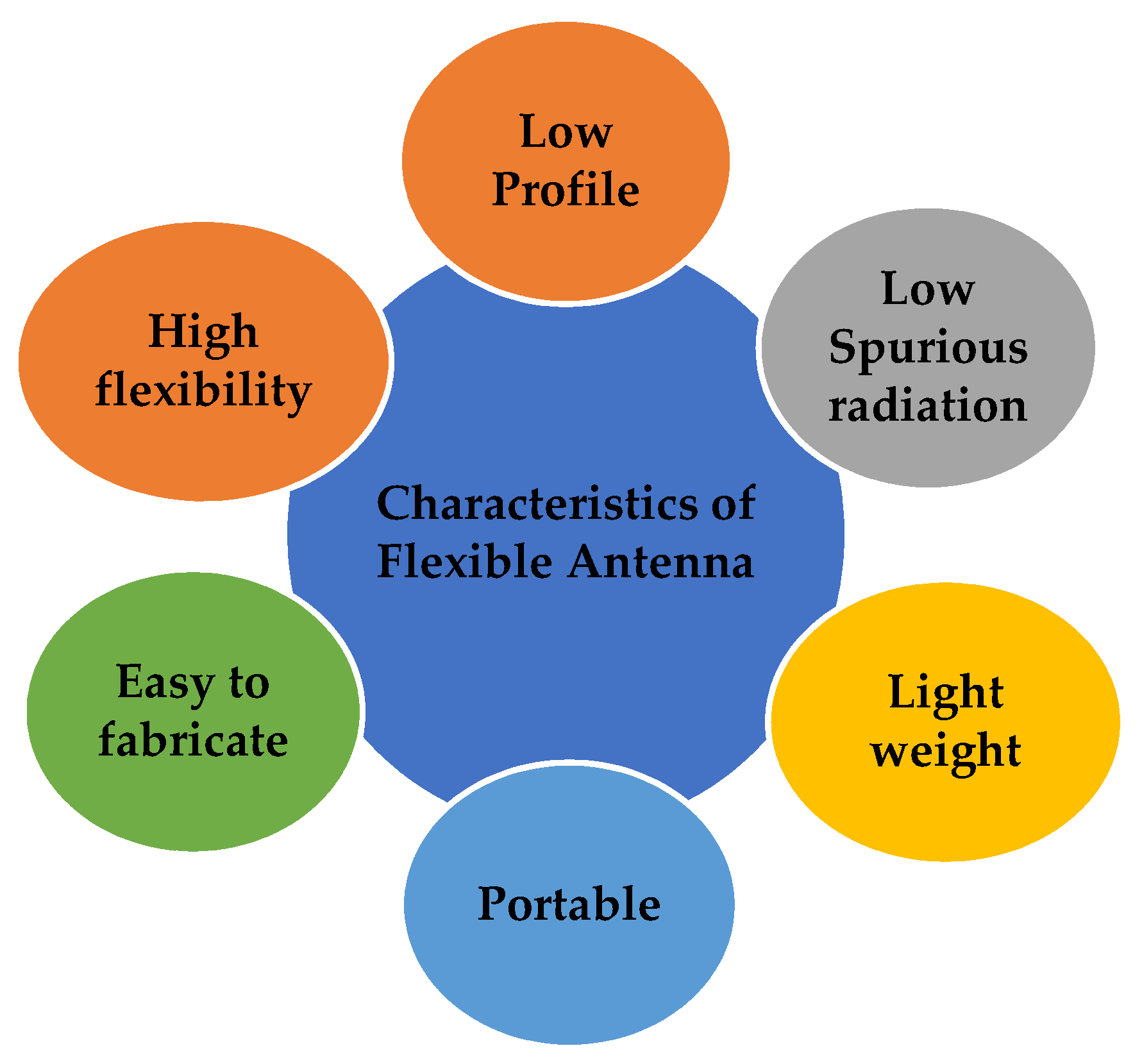

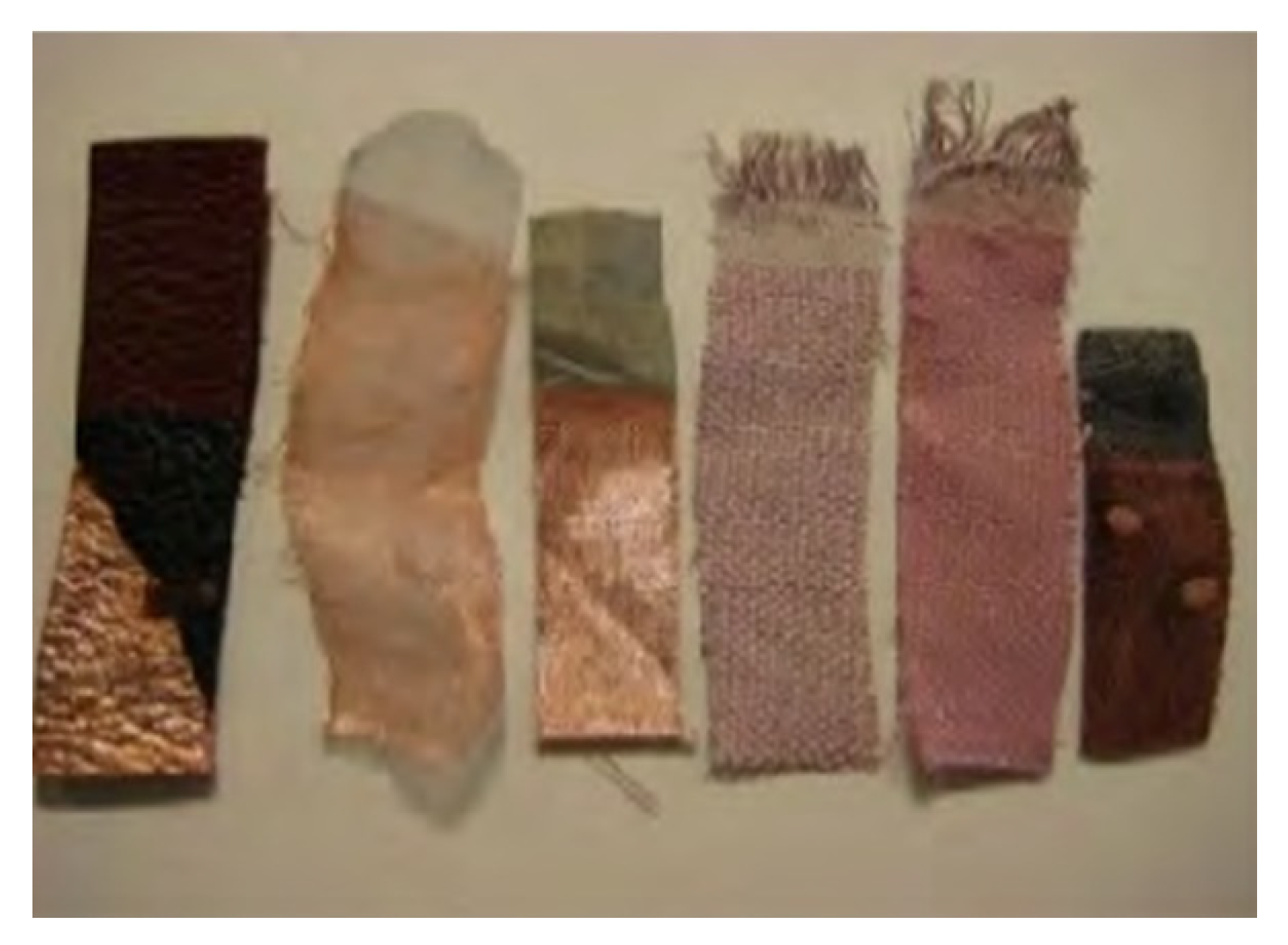

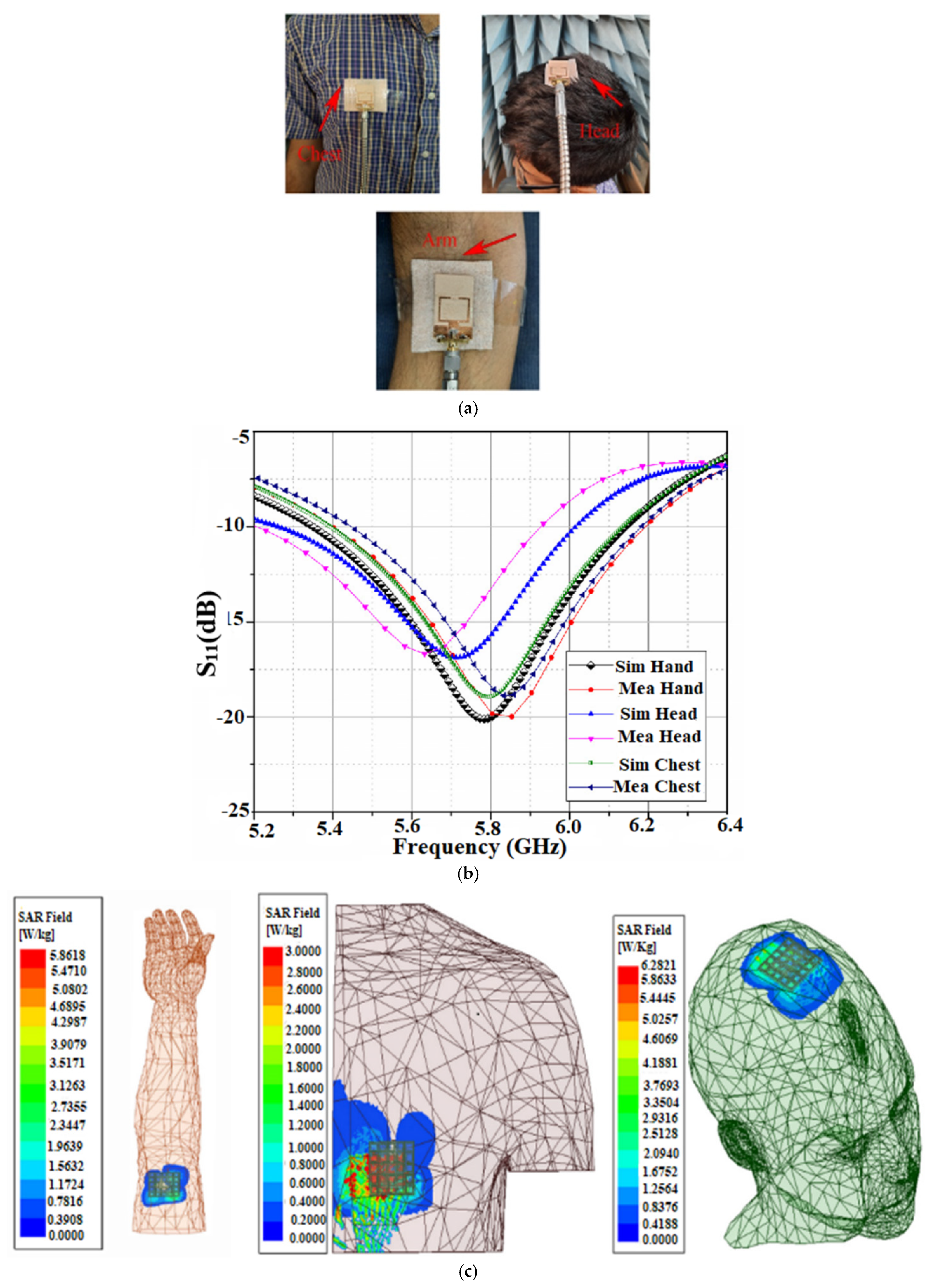
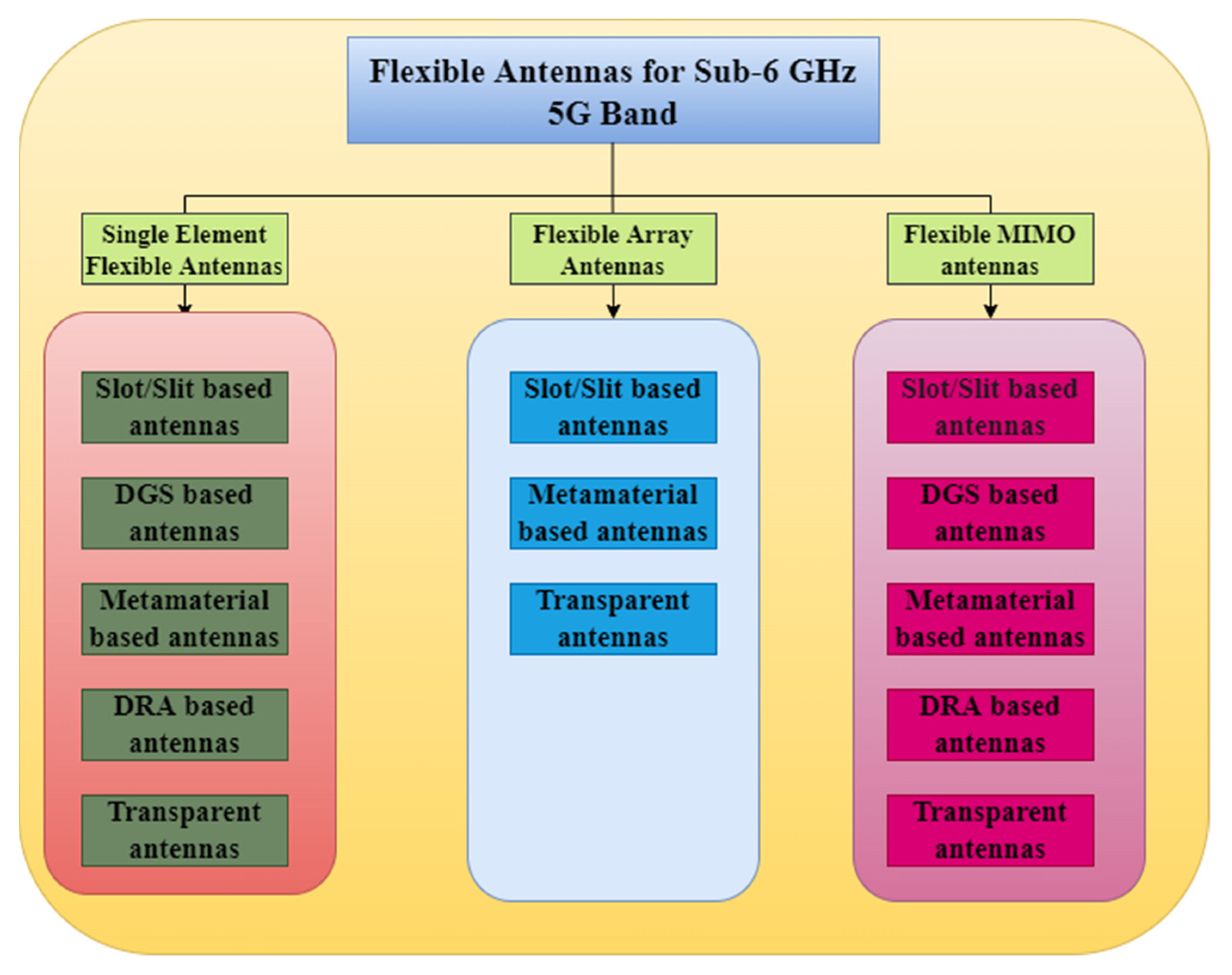

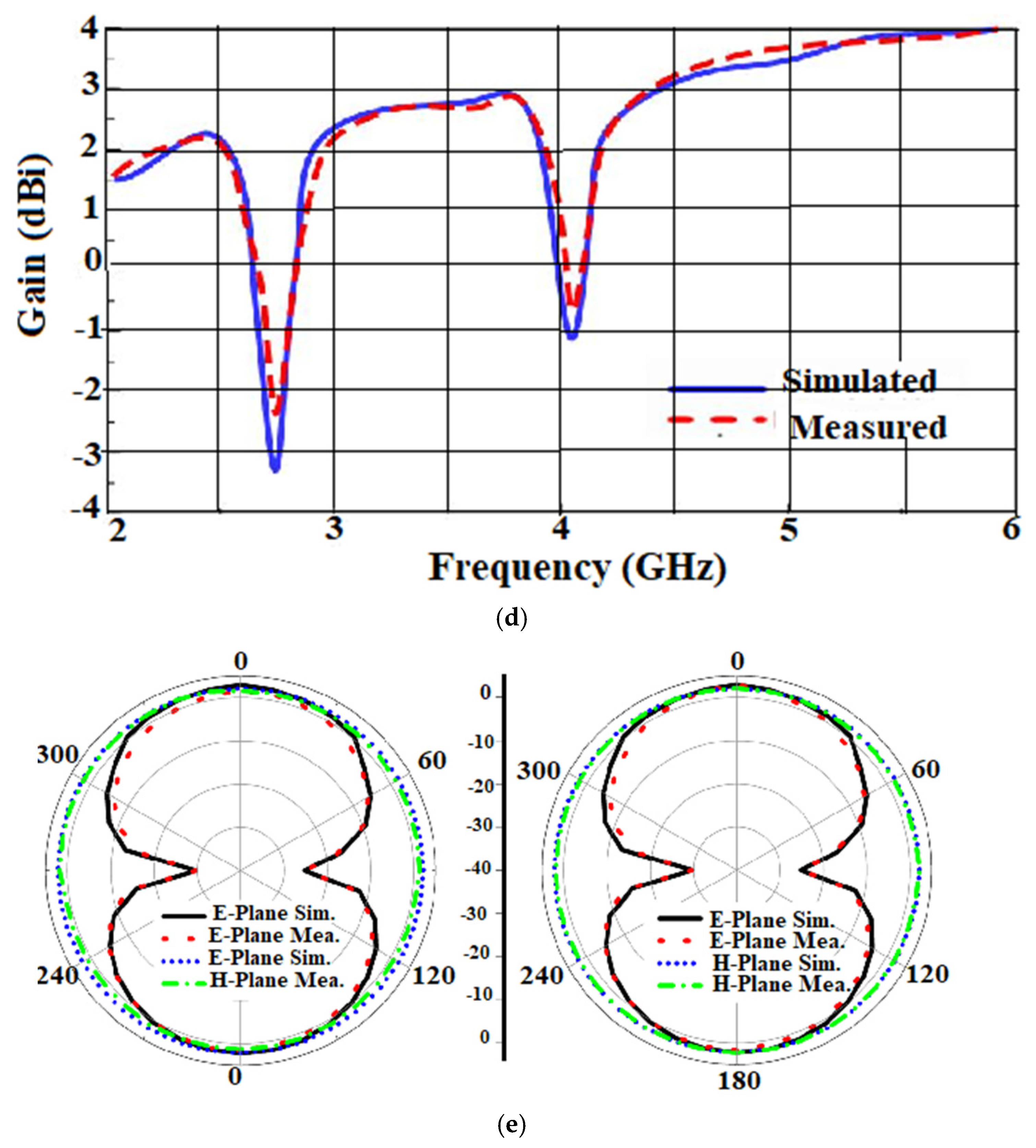

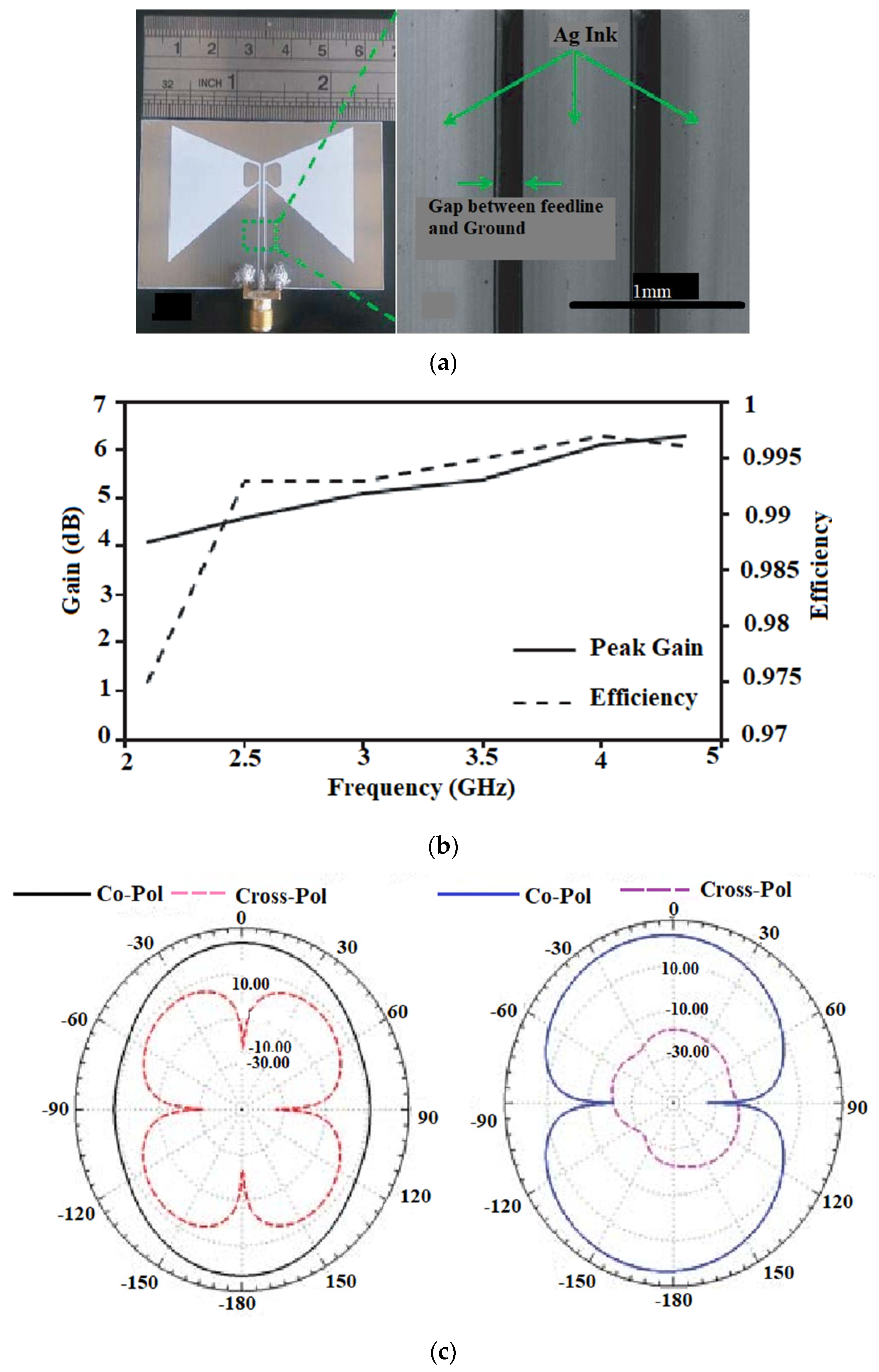
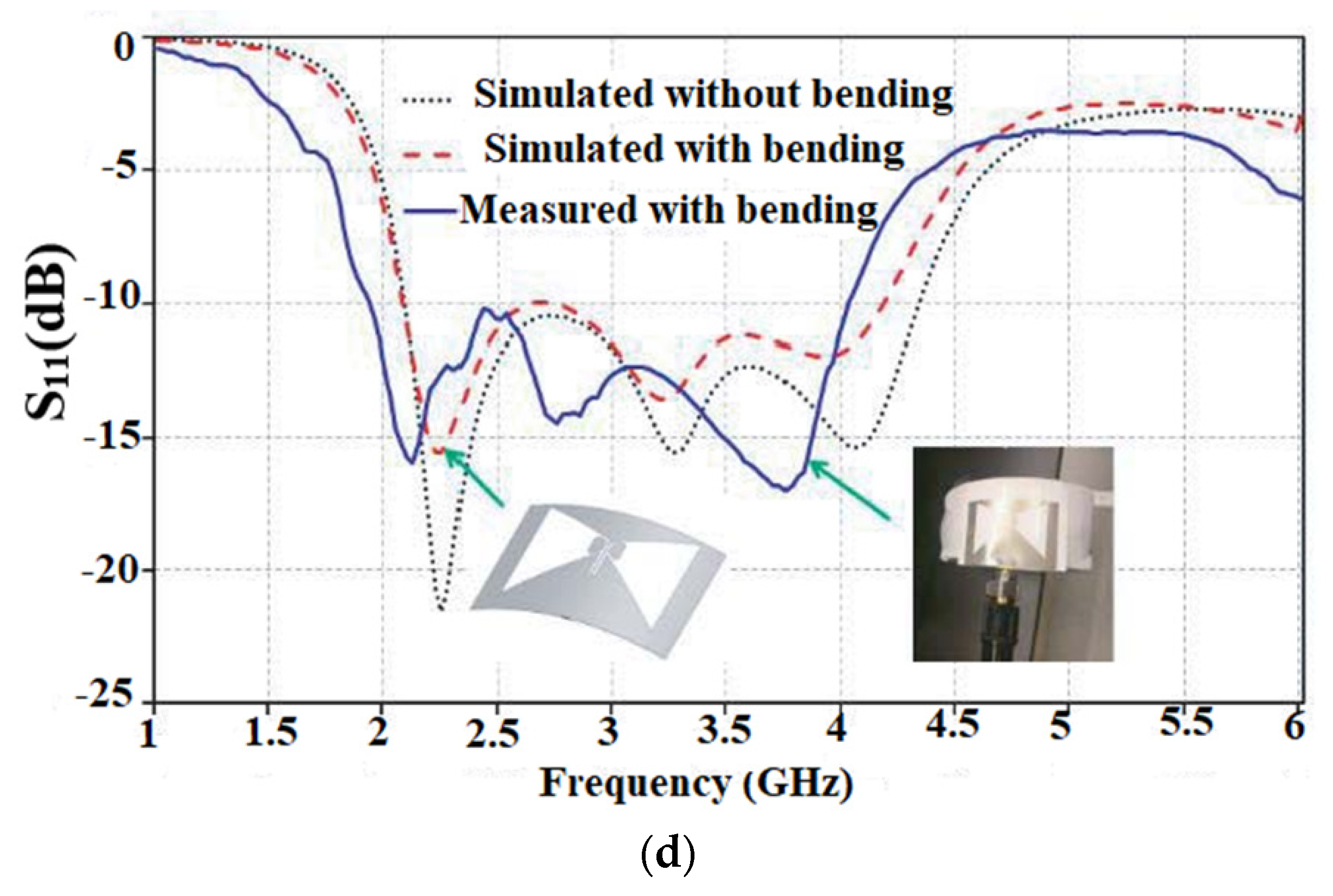


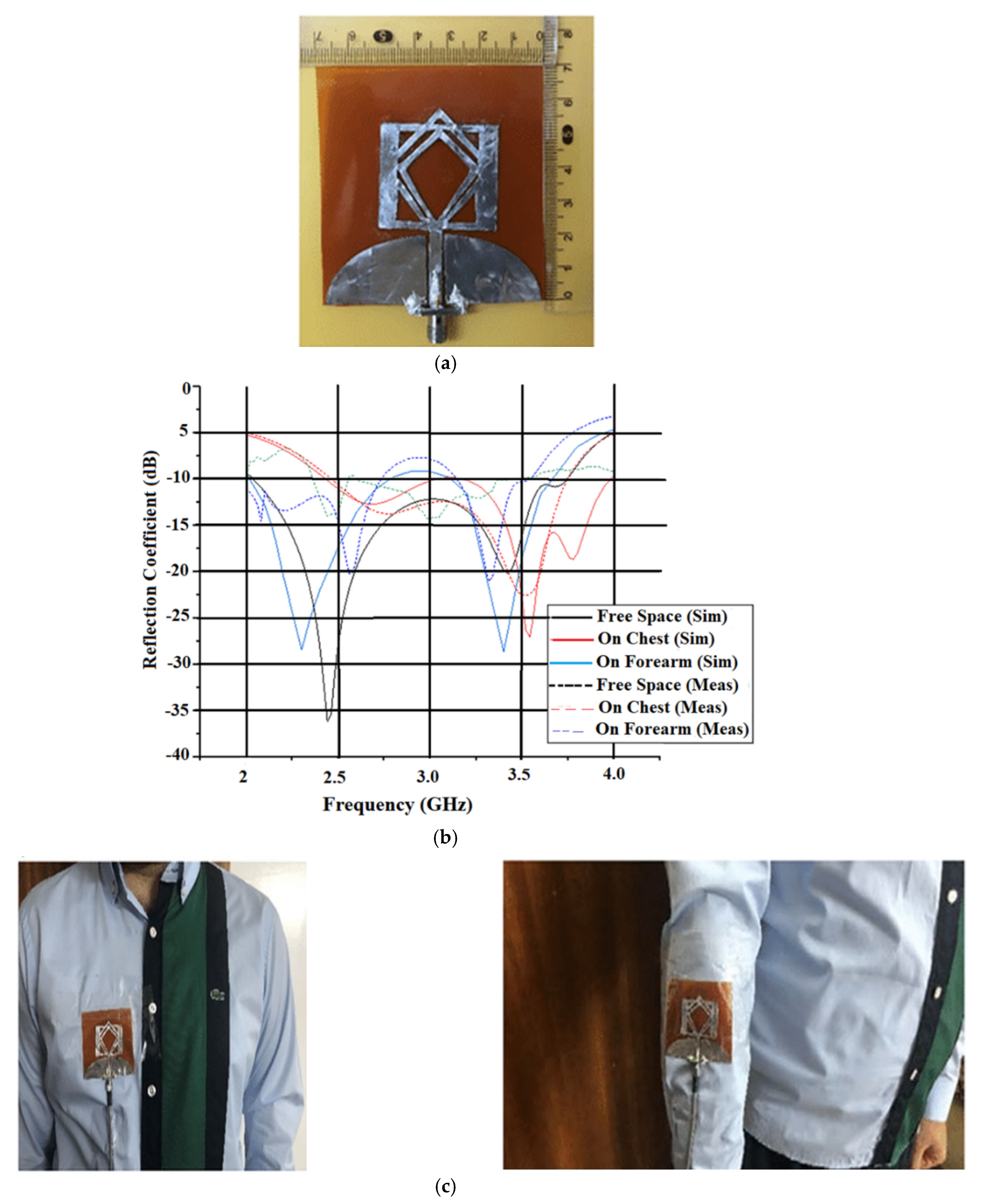

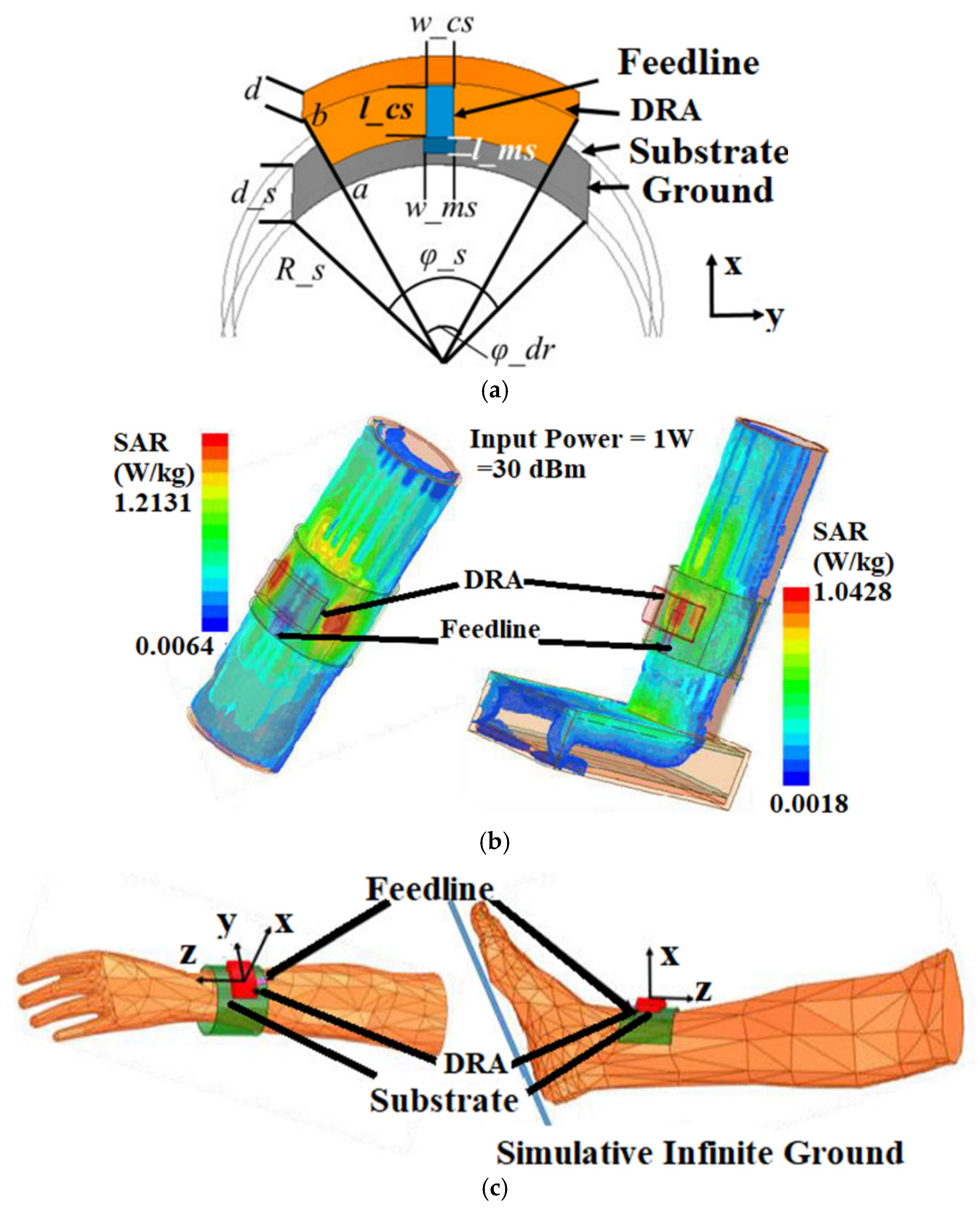
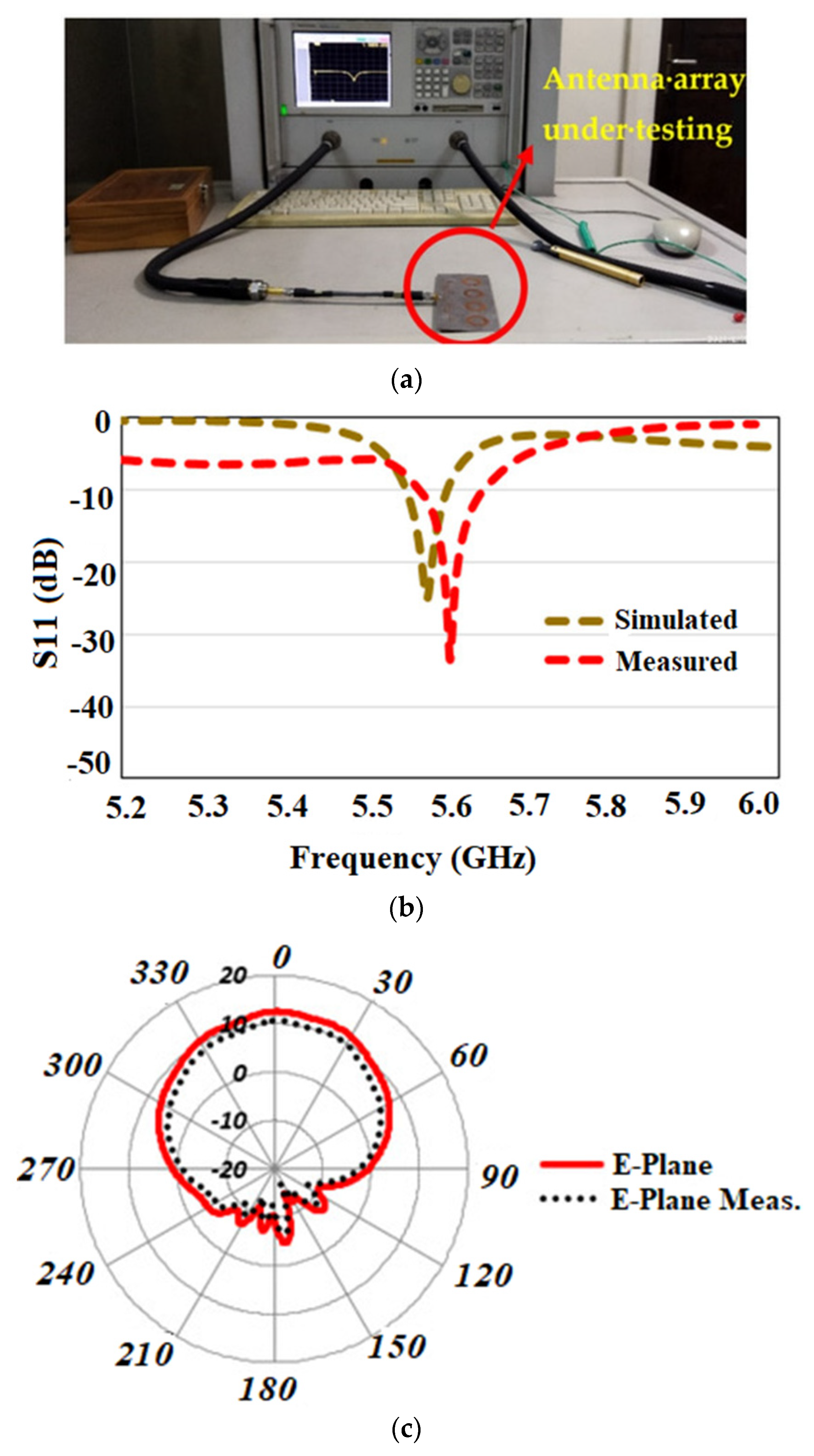
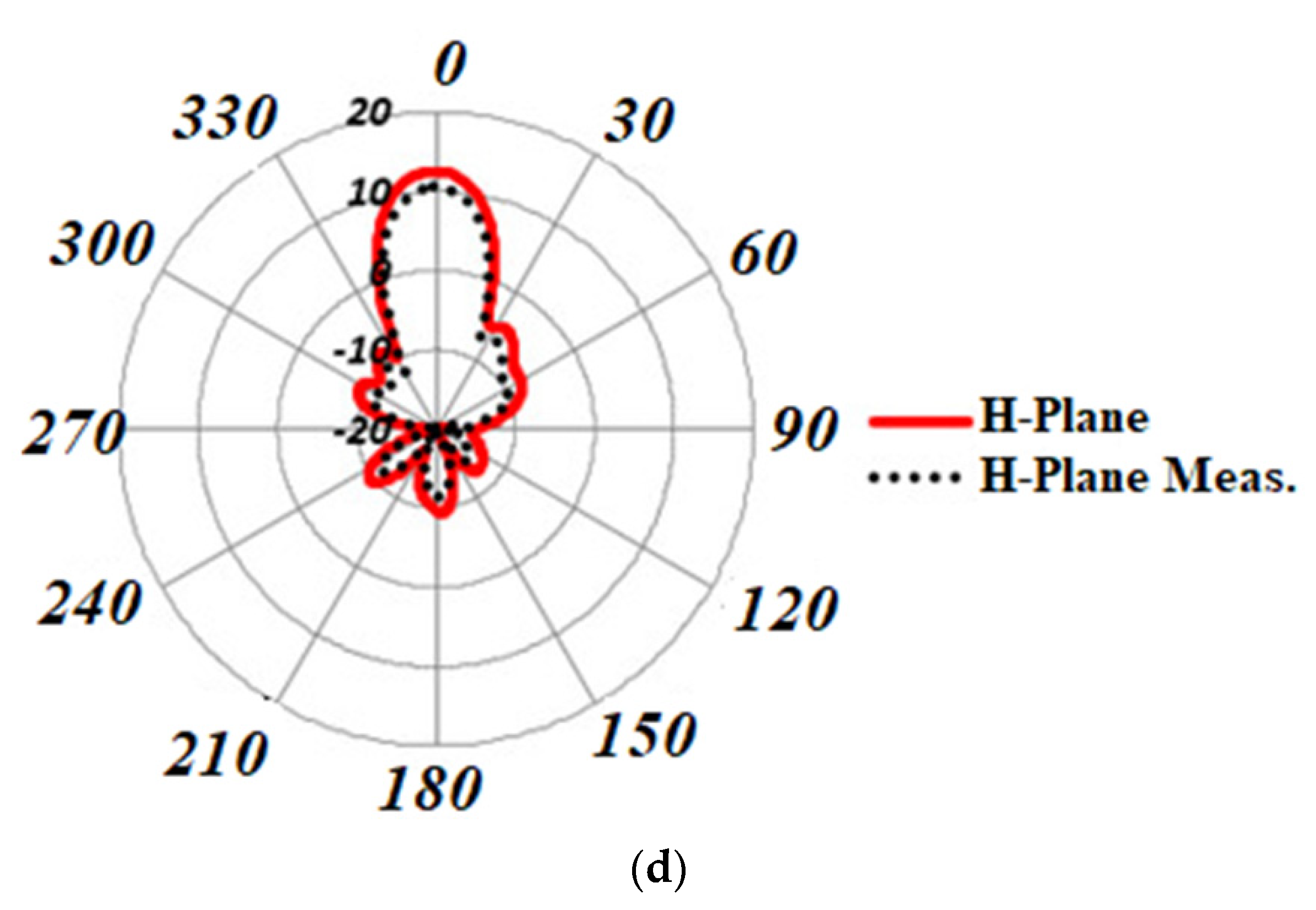
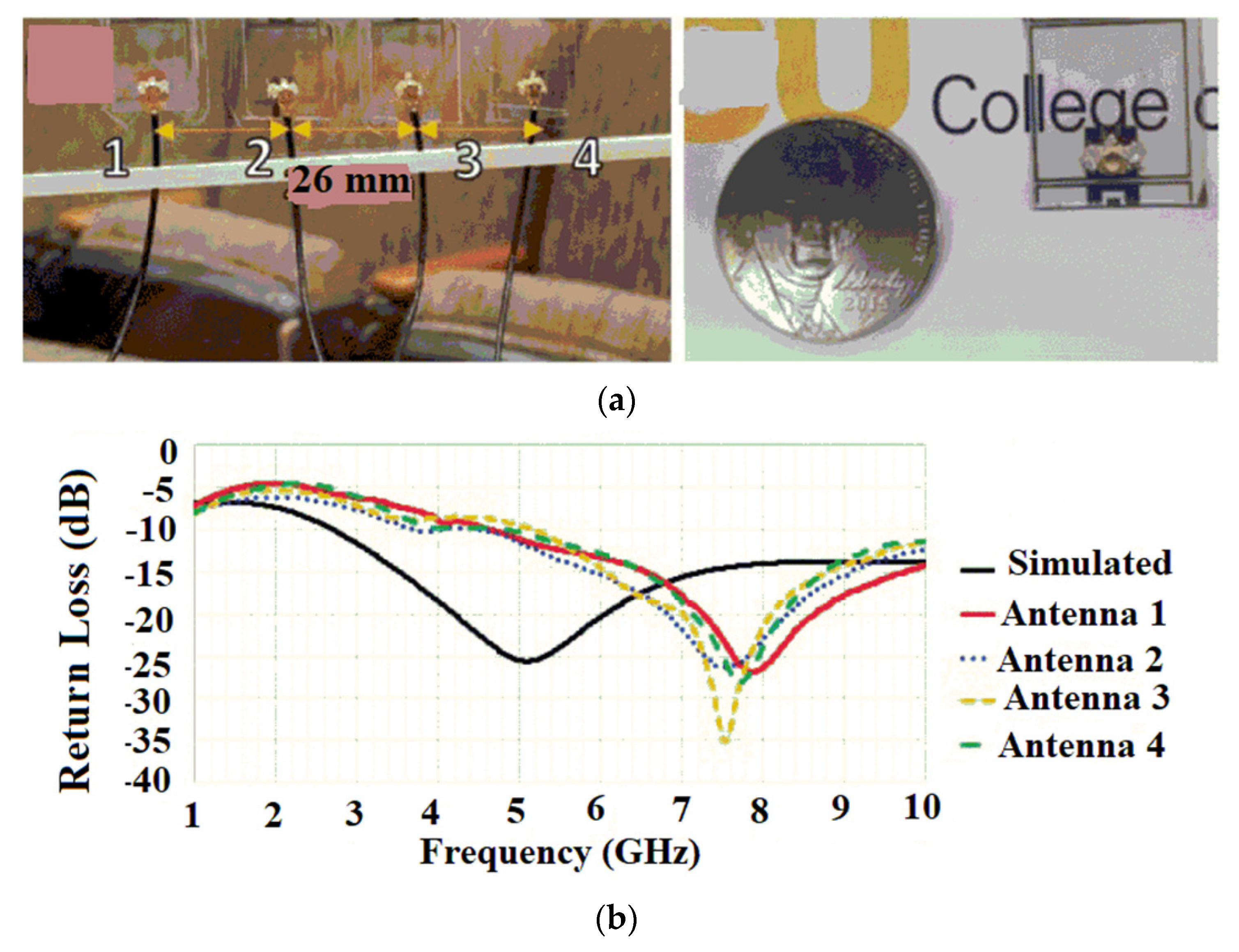


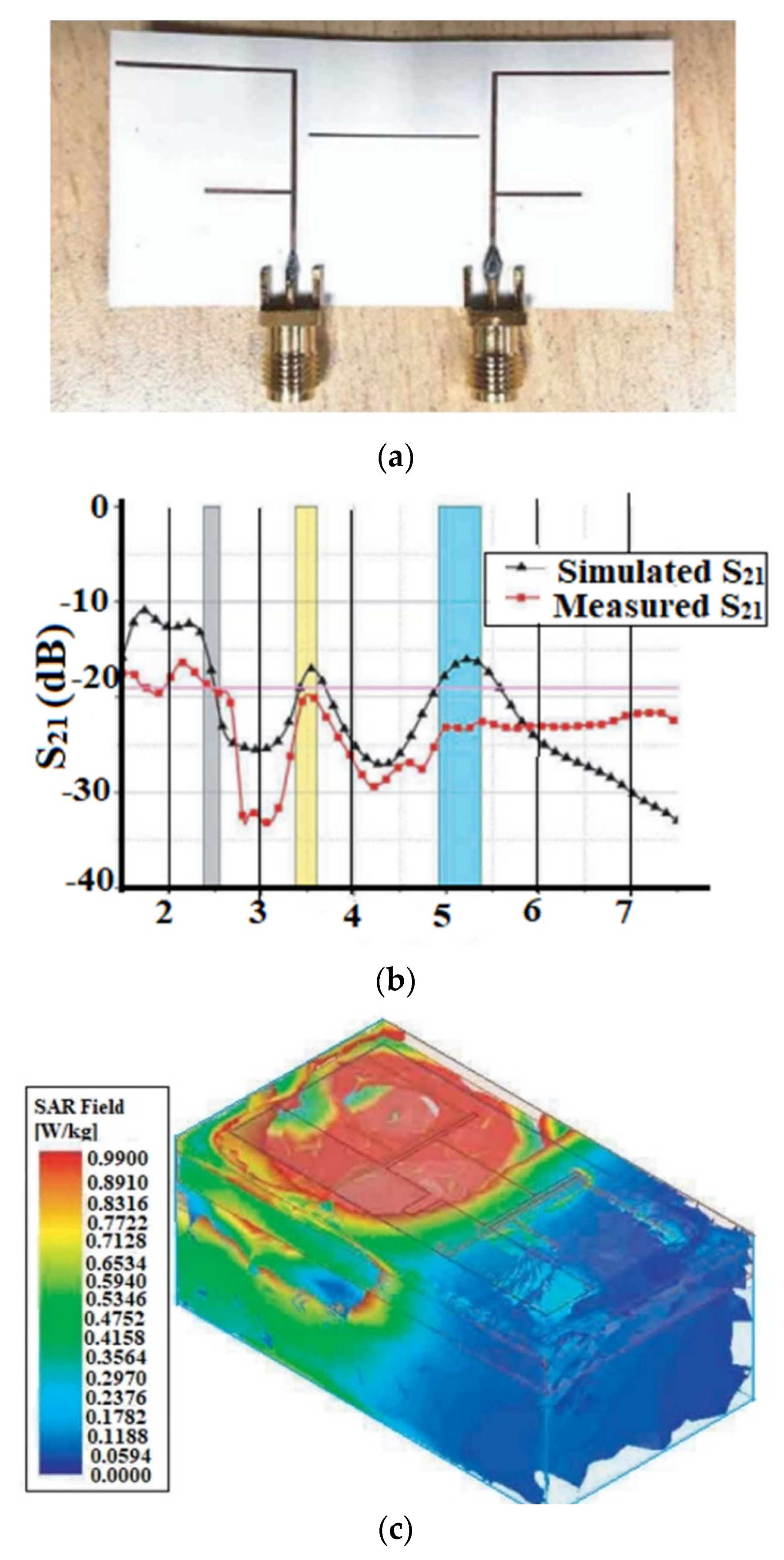

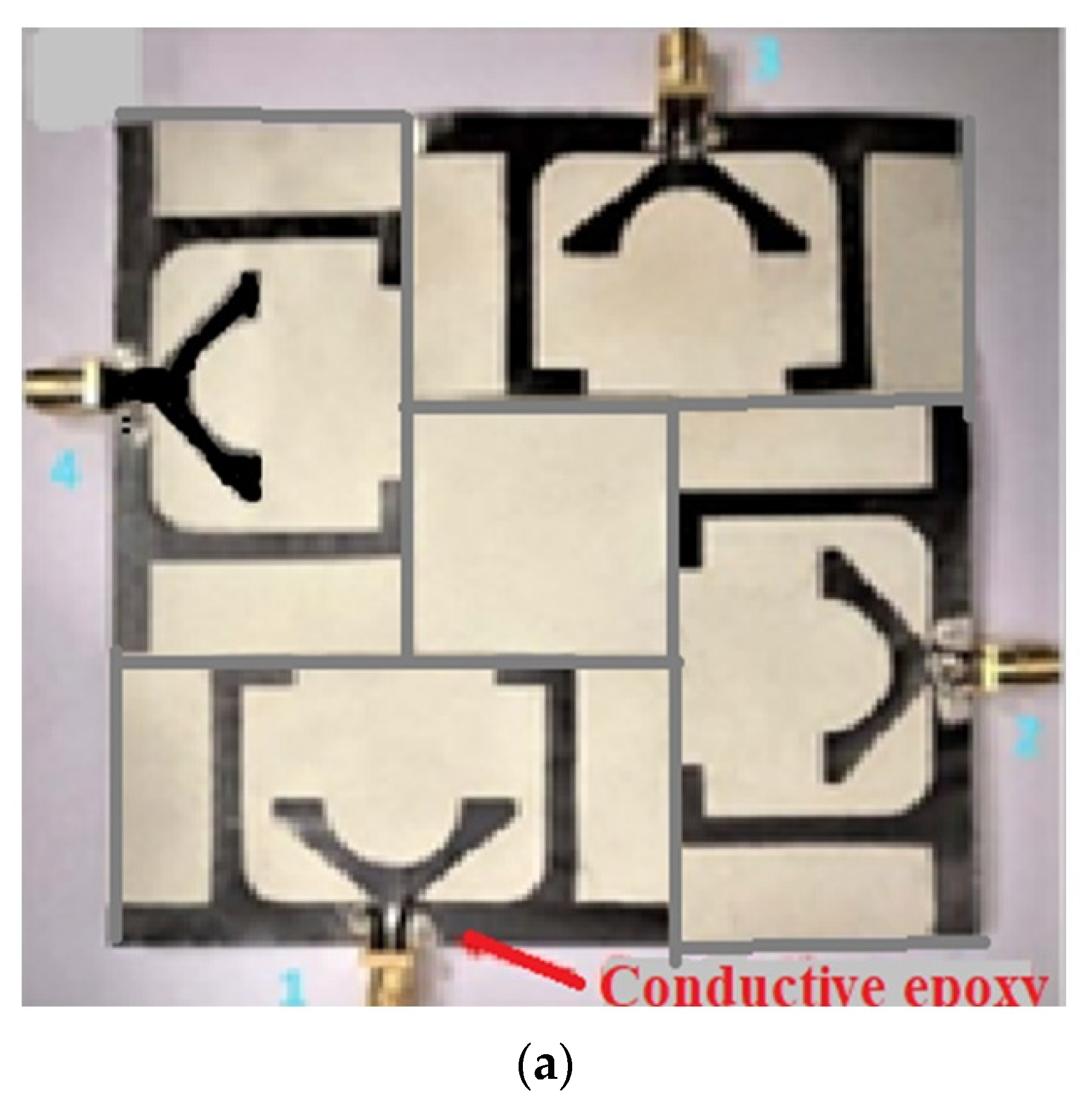
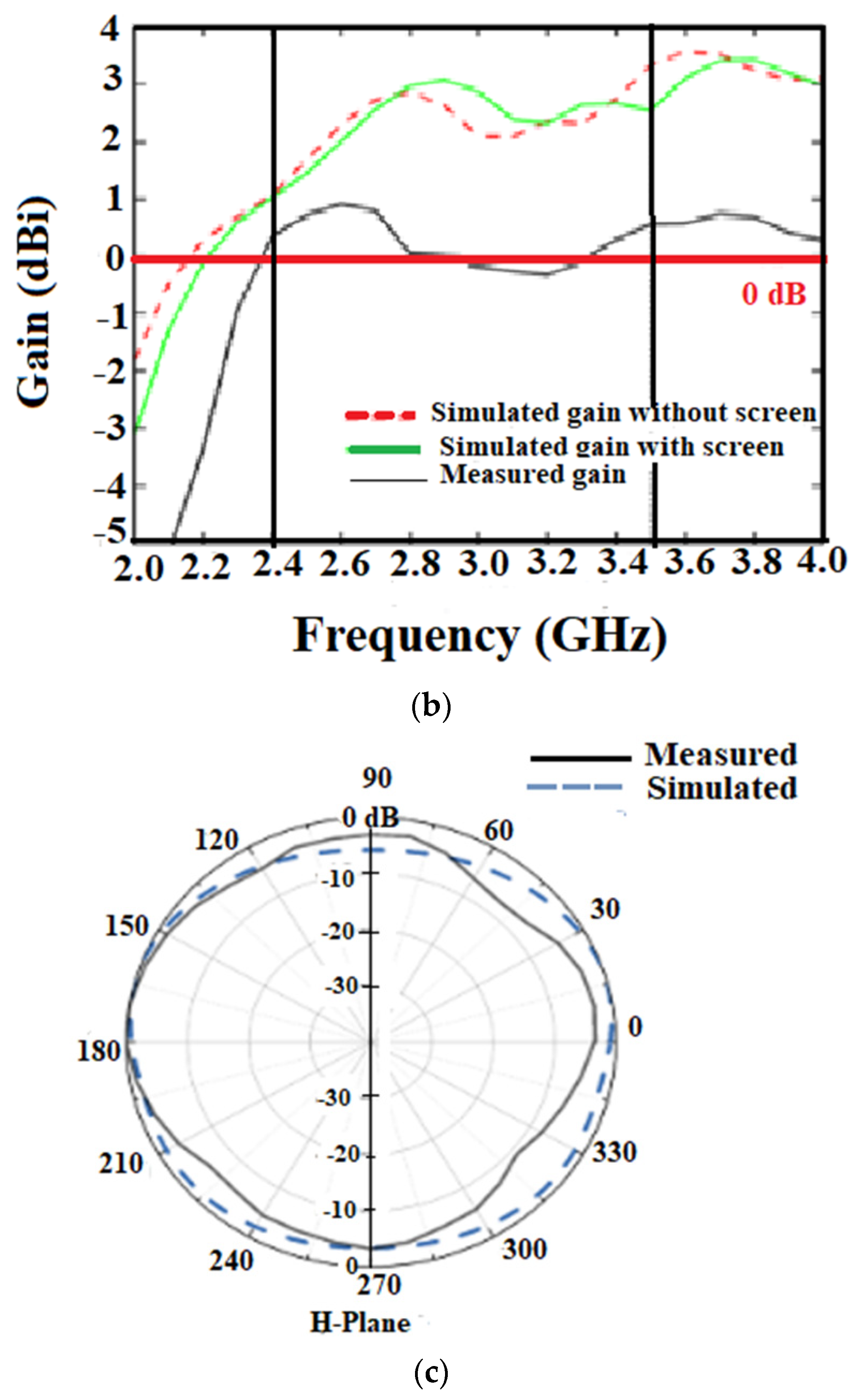


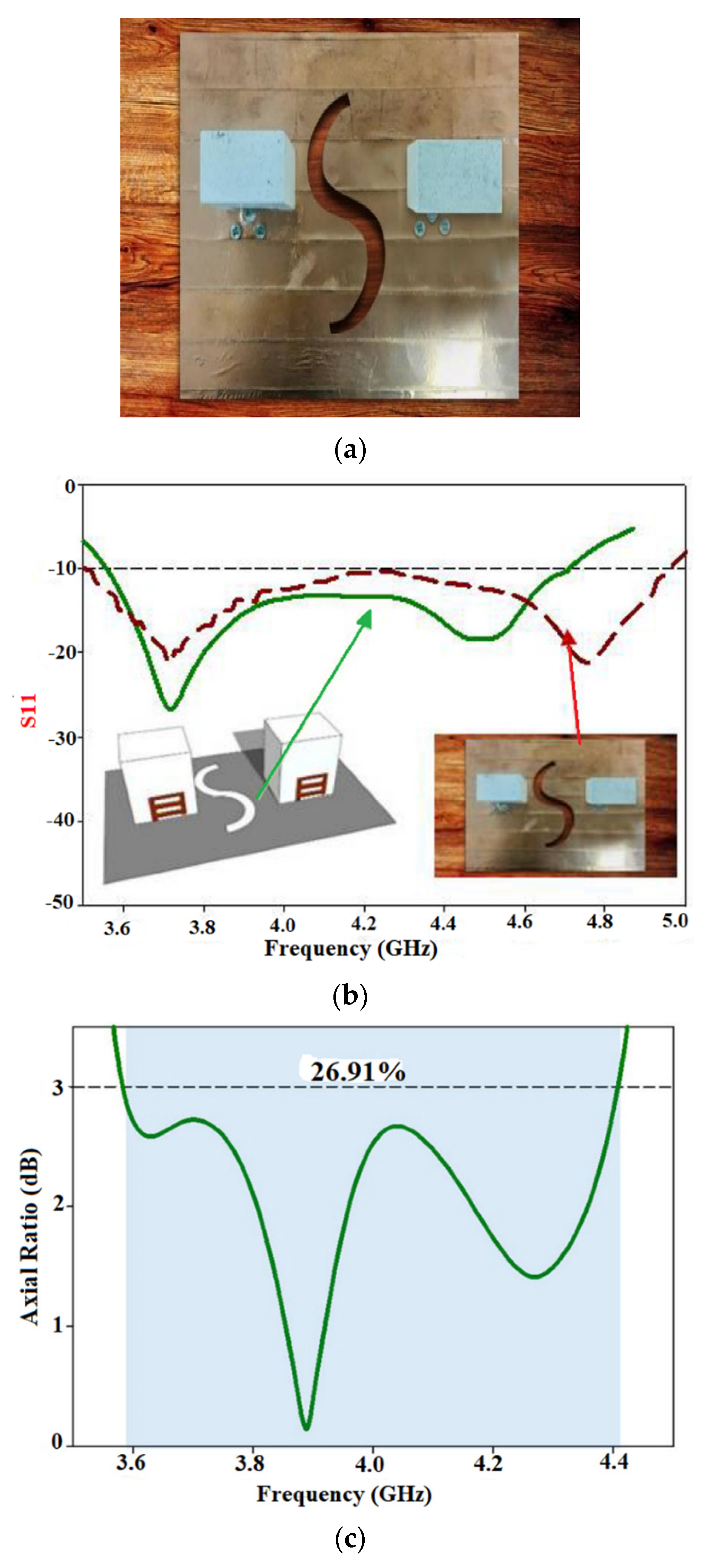
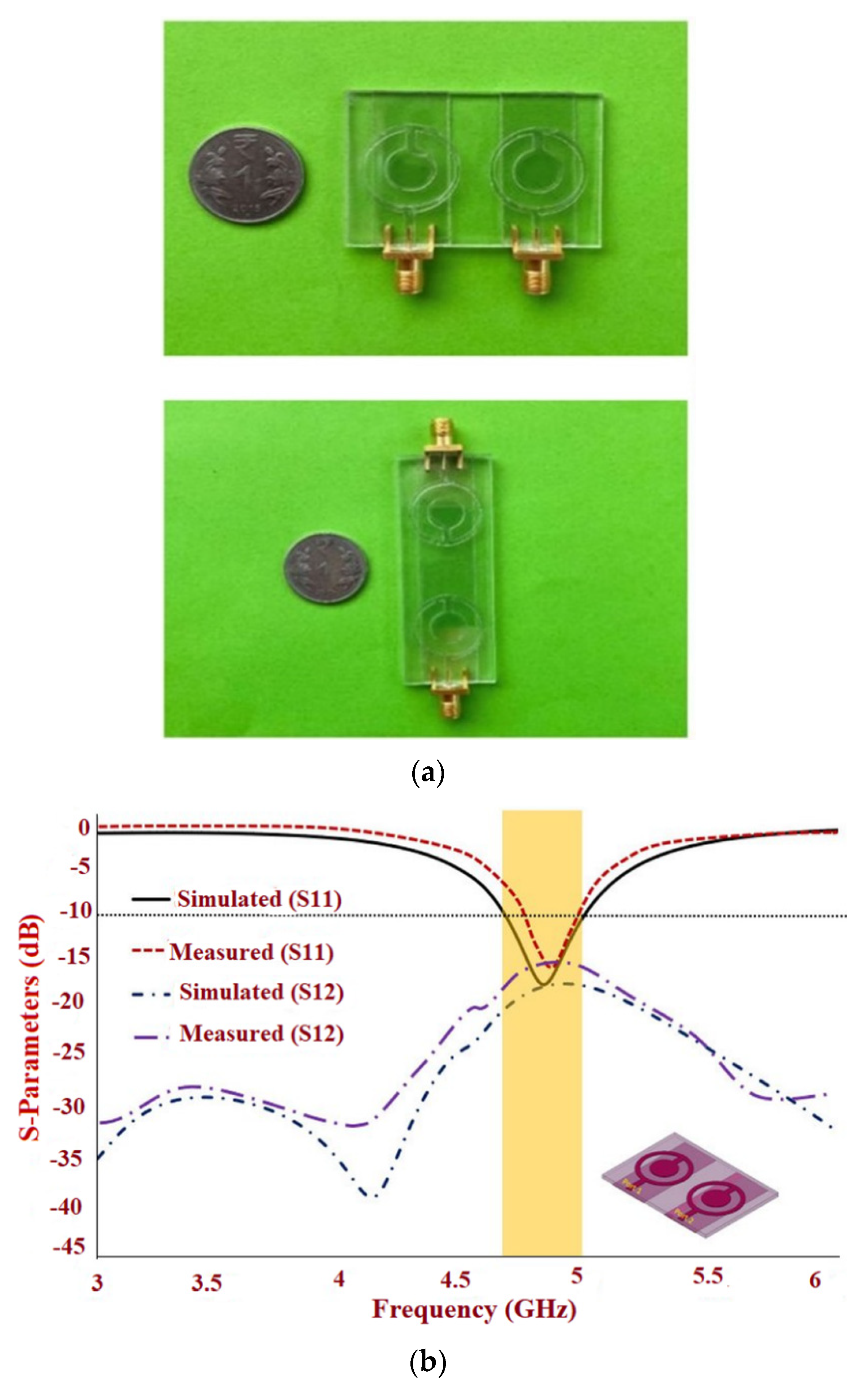

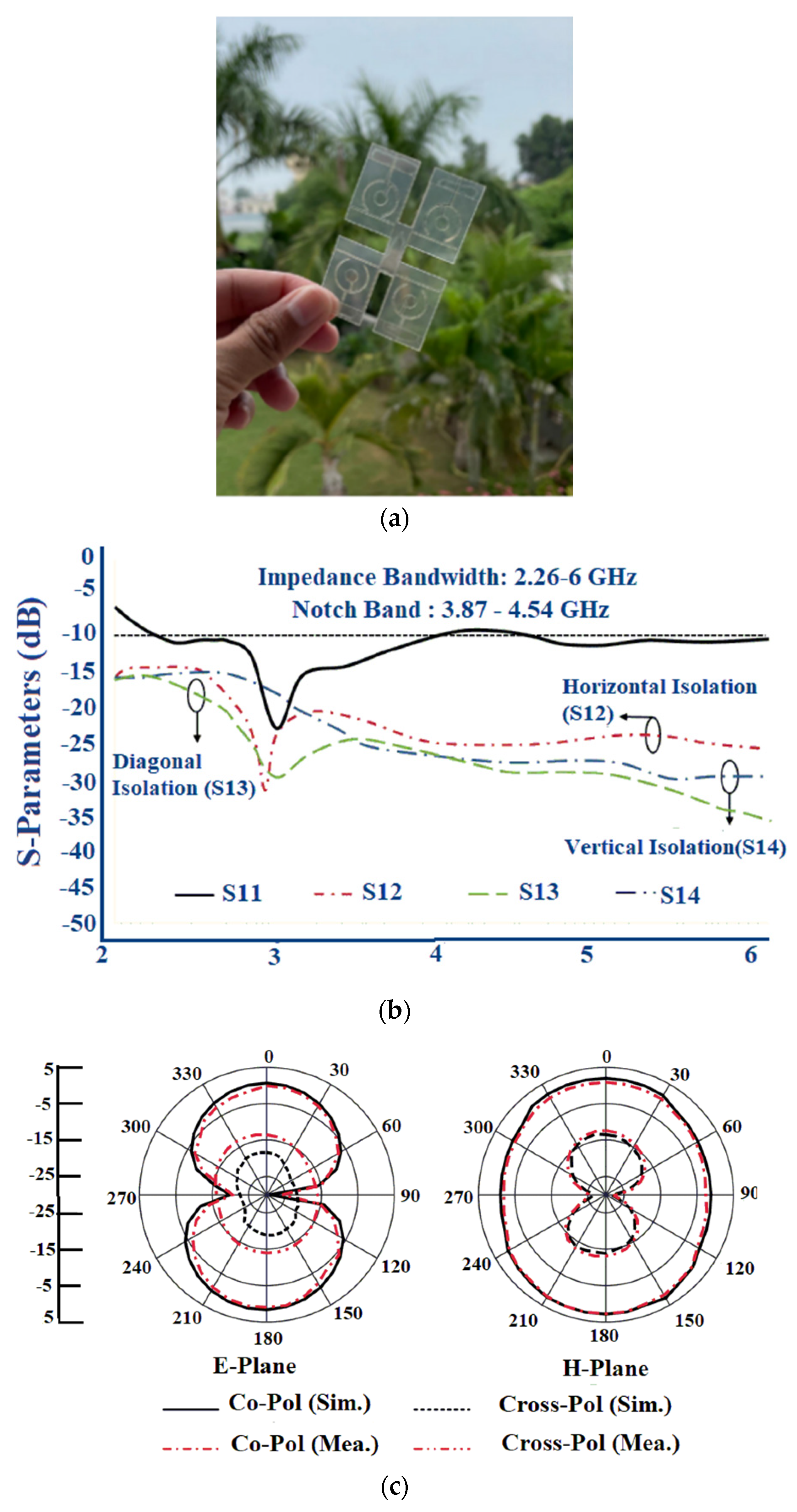
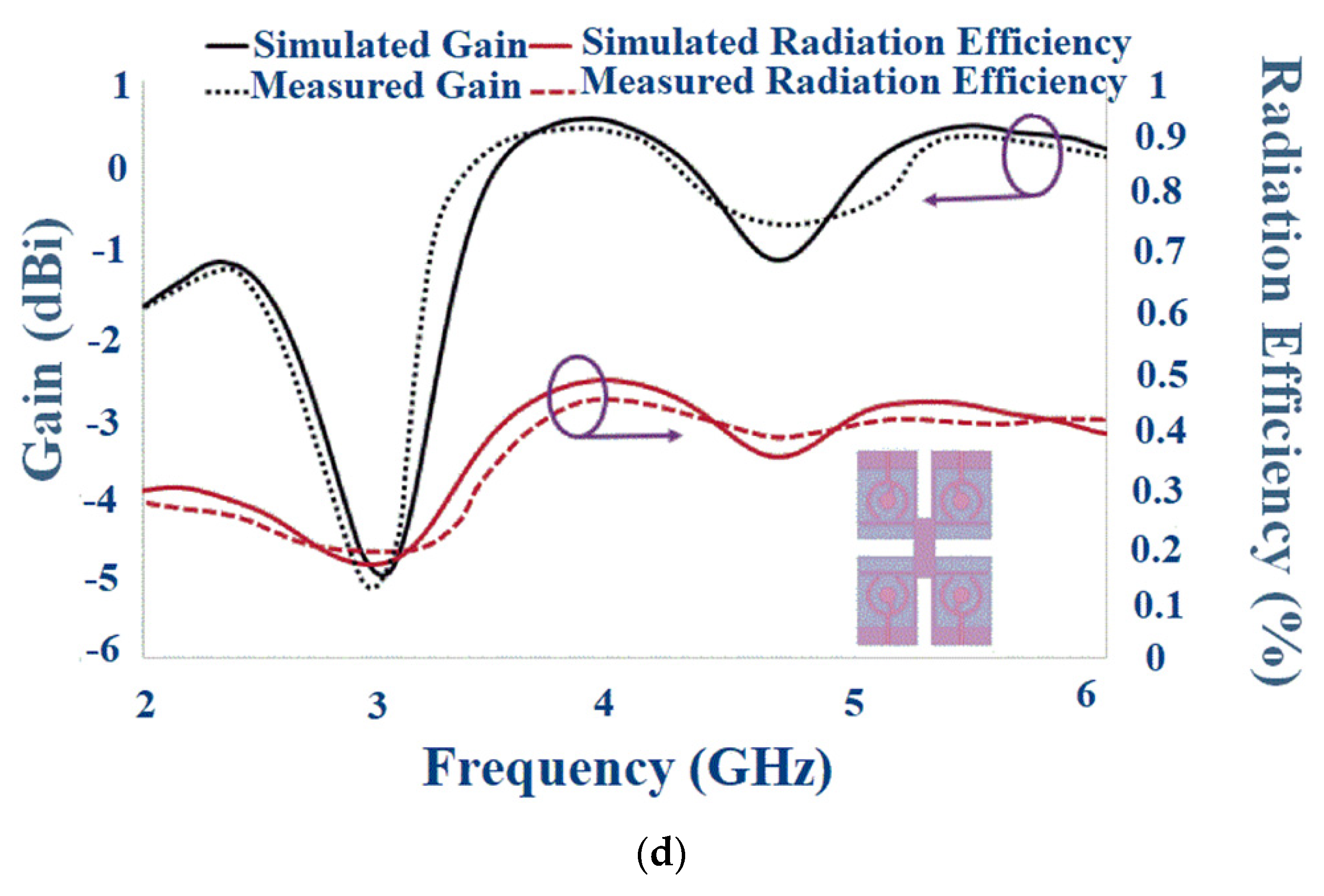
| Countries | 1 to 3 GHz Band | 3 to 4 GHz Band | 4 to 5 GHz Band |
|---|---|---|---|
| Korea | 2.30 to 2.39 GHz | 3.40 to 3.70 GHz, 3.70 to 4.00 GHz | |
| Japan | 3.60 to 4.10 GHz | 4.50 to 4.90 GHz | |
| China | 2.50 or 2.60 GHz (B41 or n41) | 3.30 to 3.60 GHz | 4.50 to 5.00 GHz |
| EU | 3.40 to 3.80 GHz | ||
| UK | 3.40 to 3.80 GHz | ||
| Germany | 3.40 to 3.80 GHz | ||
| France | 3.46 to 3.80 GHz | ||
| Italy | 3.60 to 3.80 GHz | ||
| USA | 2.50 or 2.60 GHz | 3.45 to 3.70 GHz, 3.70 to 3.98 GHz | 4.49 to 4.99 GHz |
| Canada | 3.47 to 3.65 GHz, 3.65 to 4.00 GHz | ||
| Australia | 3.40 to 3.70 GHz | ||
| India | 3.30 to 3.60 GHz |
| Conductive Materials | Advantages | Disadvantages | |
|---|---|---|---|
| Silver Nanoparticles | High electrical conductivity | Expensive | |
| PANI/CCo Composite | Good mechanical properties | Low conductivity | |
| Paper | Easy availability | Low Stability | |
| Meshed Fabric | Easy availability, Low profile | Low fabrication accuracy | |
| Nano Flakes | Good thermal stability | Less radiation efficiency | |
| Graphene Assembled Film | High electrical conductivity | Expensive fabrication | |
| Copper Nanoparticle/Copper Mesh | Good conductivity, good radiation characteristics | High oxide formation | |
| AgHT | Transparency | Low resistivity | |
| AgNW | Conformality | Low durability, high roughness |
| Properties | Polymer | Textile | Paper | Fluidic |
|---|---|---|---|---|
| Dielectric Loss/Loss Tangent | Low Loss | Low Loss | Medium Loss | High Loss |
| Tensile Strength | High | Low | Low | Low |
| Deformability | Low | High | High | High |
| Thermal Stability | High | Low | Low | Low |
| Fabrication Complexity | Simple | Complex | Simple | Complex |
| Robustness to Wetness | High | Medium | Low | Low |
| Cost of Fabrication | Medium | Low | Low | High |
| Weight | Medium | Low | Low | Medium |
| Overall Size | Small | Large | Large | Small |
| Substrate | Thickness (mm) | Advantages | Disadvantages | ||
|---|---|---|---|---|---|
| Rogers (RO 3003) | 3 | 0.0013 | 1.52 | Low moisture absorption, good dimensional stability | Low flexibility |
| PDMS | 2.7 | 0.013 | 1 | Water-resistant, good chemical stability | Fabrication complexity, high cost |
| Photo Paper | 2.85 | 0.05 | 0.254 | Low profile, easily available | Highly fragile, high moisture absorption |
| Kapton Polymide | 3.5 | 0.002 | 0.10 | Good electrical stability, Easy to fabricate | High moisture absorption |
| Tac/Felt | 2.2 | 0.0009 | 1.52 | Low cost, easily available | High moisture absorption, less smooth |
| LCP | 2.9 | 0.022 | 0.1 | High heat resistance, good mechanical properties | Fabrication complexity, High cost |
| PEN | 2.6 | 0.005 | 0.1 | Good electrical and mechanical properties | Low thermal stability |
| PET | 3.2 | 0.022 | 0.1 | Transparency, good thermal and electrical properties, good moisture stability, and conformality | Low thermal stability |
| Body Parts | Head | Chest | Abdomen | Upper Arm | Forearm | Thigh | Lower Leg |
|---|---|---|---|---|---|---|---|
| Skin (Thickness in mm) | 4 | 2 | 2 | 2 | 2 | 2 | 2 |
| Fat (Thickness in mm) | - | 4 | 7 | 6.1 | 4.3 | 8.8 | 6.3 |
| Muscle (Thickness in mm) | 9.5 | 38 | 25 | 20.3 | 14.9 | 28.7 | 20.8 |
| Bone (Thickness in mm) | 20.5 | 46 | - | 9.1 | 6.3 | 13 | 9.4 |
| Grey Matter (Thickness in mm) | 51 | - | - | - | - | - | - |
| Heart (Thickness in mm) | - | - | 56 | - | - | - | - |
| Tissue Layers | Conductivity σ (S/m) | |
|---|---|---|
| 2.4 GHz | ||
| Skin | 42.85 | 1.59 |
| Fat | 10.82 | 0.27 |
| Muscle | 53.6 | 1.81 |
| 3.5 GHz | ||
| Skin | 41.41 | 2.35 |
| Fat | 10.5 | 0.42 |
| Muscle | 52.12 | 2.72 |
| 5 GHz | ||
| Skin | 35.78 | 3.06 |
| Fat | 5.03 | 0.24 |
| Muscle | 49.54 | 4.04 |
| Ref | Size () | Bandwidth (GHz) | Gain (dBi) | SAR | Bending/Effect | Substrate, , tanδ | Advantages | Disadvantages |
|---|---|---|---|---|---|---|---|---|
| [29] | 3.89–5.9 | 3 | - | x-axis and y-axis/Slight variation in resonant frequency | PET 3.2, 0.022 | Transparent | Thickness of substrate | |
| [47] | 2.85–5.35 2.35–2.5 3.18–3.82 4.15–5.42 | 3.75 2.1 2.8 3.5 | - | Bending across different radii/Negligible effect on return loss | Ultra-thin Rogers, 3.52, 0.003 | Compact size | Negative gain values at cut-off frequencies | |
| [48] | 3.13–4.42 | - | - | Tensile and compressive bending across different radii/High durability of antenna even after 100 bending cycles | PET, 3.5, 0.022 | Miniatured size | Slight difference in input impedance of the designed and fabricated antenna | |
| [50] | 2.38–2.79 3.27–4.05 4.80–8.44 | 0.65 2.26 2.6 | 0.93 (2.4 GHz) 0.89 (3.5 GHz) 1.92 (5 GHz) (10 g tissue) | E-plane and H-plane bending across different radii/Slight difference in resonance for E-plane bending | LCP 2.9, 0.002 | Low antenna volume | Low gain | |
| [51] | 2.038–3.745 | 3 (2.45 GHz) 5 (3.42 GHz) | 0.908 (forearm) 0.782 (chest) (1 g tissue) 0.468 (forearm) 0.342 (chest) (10 g of tissue) | - | Kapton Polyimide 3.5, 0.002 | Good radiation efficiency, highly flexible | Complex structure | |
| [52] | 1.77–6.95 | 2.5–5.9 | - | Bending across different radii/Stable performance | Kapton Polyimide 3.5, 0.007 | Simple configuration | Variation in measured results due to material specifications | |
| [53] | 2.40–2.54 3.38–3.52 | 6.7 8.9 | 0.2 and 0.1 (2.45 GHz) (1 g of tissue) 0.1 and 0.04 (3.45 GHz) For 10 g of tissue | x- and y-axis bending across different radii/A negligible shift in frequency compared to a flat condition | Felt/Tac 2.2, 0.0009 | Good gain and efficiency | Less conformal | |
| [55] | 2.52–2.62 3.31–3.64 | 2.39 (2.60 GHz) 1.75 (3.48 GHz) | - | Convex bending across different radii/No significant change in antenna performance | Polyimide 3.5, 0.002 | Low volume | Radiation pattern not stable | |
| [56] | 3.4–3.78 5.7–6.9 | - | - | Bending across different degrees/30° bending showed triple band variation | LCP 2.9, 0.0025 | Conformal due to the low thickness of the substrate | Complex fabrication | |
| [57] | 3.1–3.9 5.4–6.2 | 9.078 7.665 (With reflector) | 0.0683 (3.5 GHz) 0.333 (5.8 GHz) (1 g of tissue) 0.226 (3.5 GHz) 0.0814 (5.8 GHz) (10 g of tissue) | - | Rogers ULTRALAM 3850 2.9, 0.0025 | Improved gain, reduced SAR | Large volume | |
| [60] | 5.4–5.9 | 4.3 (5.8 GHz) | 0.105 (1 g of tissue), 0.27 (10 g of tissue) | - | Fabric | Good gain | Low bandwidth |
| Ref | Size | Bandwidth (GHz) | Isolation (dB) | Number of Elements, Isolation Technique | Gain (dB) | SAR | Bending/Effect | ECC | DG (dB) | TARC (dB) | MEG (dB) | CCL (Bits/s/Hz) |
|---|---|---|---|---|---|---|---|---|---|---|---|---|
| [73] | 2.35–2.55 3.37–3.60 4.92–5.37 | 19 | 2, Defected ground plane | 3.79 | 0.64 for 10 g tissue | E- and H-plane bending/Negligible effect | 0.05 | 9.95 | −10 | - | - | |
| [74] | 1.5–3.8 4.2–6.2 | 25–33 | 4, Meander lines | 2.0–5.0 | <1.6 | - | 0.1 | >9.8 | −10 | 3 | - | |
| [75] | 3–11 | 19 | 2, Stub at the ground surface | - | 0.62 for 1 g of tissue | - | 0.06 | <9.975 | - | <0.2 | - | |
| [76] | 2.22–3.85 | 30 | 4, Stub extended from the ground plane | 0.56 | - | Horizontal and Vertical Bending/Deterioration in reflection coefficient | 0.2 | - | - | - | 0.2 | |
| [77] | 3.34–5.01 8.9–9.2 | 20 | 4, Defected ground Plane | 4 | - | x-axis and y-axis bending/Negligible effect on bandwidth | 0.17 | - | - | - | - | |
| [81] | Case 1: Case 2: | 4.65–4.97 4.67–4.94 | 17.44 17.47 | 2, Partial ground plane 2, the distance between the elements | 1.83 1.65 | - | - | 0.02 0.02 | 9.96 9.94 | >−15 >−12 | 1 1 | 0.10 0.15 |
| [82] | 2.21–6 | 15 | 4, Defected ground plane | 0.53 | - | A 300° horizontal and vertical bending/Variation in gain | <0.016 | ~10 | - | - | - |
| Scaled Net Input Power 100 mW | Maximum Mean SAR for 1 g Tissue (W/kg) | Maximum Mean SAR for 10 g Tissue (W/kg) |
|---|---|---|
| Distance (in mm) | ||
| 0.0 | 0.864 | 0.273 |
| 1.0 | 0.420 | 0.199 |
| 2.0 | 0.203 | 0.104 |
| 3.0 | 0.134 | 0.077 |
| 4.0 | 0.107 | 0.070 |
| 5.0 | 0.100 | 0.069 |
| 6.0 | 0.094 | 0.068 |
Publisher’s Note: MDPI stays neutral with regard to jurisdictional claims in published maps and institutional affiliations. |
© 2022 by the authors. Licensee MDPI, Basel, Switzerland. This article is an open access article distributed under the terms and conditions of the Creative Commons Attribution (CC BY) license (https://creativecommons.org/licenses/by/4.0/).
Share and Cite
John, D.M.; Vincent, S.; Pathan, S.; Kumar, P.; Ali, T. Flexible Antennas for a Sub-6 GHz 5G Band: A Comprehensive Review. Sensors 2022, 22, 7615. https://doi.org/10.3390/s22197615
John DM, Vincent S, Pathan S, Kumar P, Ali T. Flexible Antennas for a Sub-6 GHz 5G Band: A Comprehensive Review. Sensors. 2022; 22(19):7615. https://doi.org/10.3390/s22197615
Chicago/Turabian StyleJohn, Deepthi Mariam, Shweta Vincent, Sameena Pathan, Pradeep Kumar, and Tanweer Ali. 2022. "Flexible Antennas for a Sub-6 GHz 5G Band: A Comprehensive Review" Sensors 22, no. 19: 7615. https://doi.org/10.3390/s22197615







